75 TH ANNIVERSARY
Tactics Changed for Keeps at Riga in 1917
The British Sniper Patriots Loathed What Painters Got Wrong About War
A Medal of Honor for...Snuffy Smith?

75 TH ANNIVERSARY
Tactics Changed for Keeps at Riga in 1917
The British Sniper Patriots Loathed What Painters Got Wrong About War
A Medal of Honor for...Snuffy Smith?
A TRIBUTE TO AIRMEN WHO PULLED OFF THE ‘IMPOSSIBLE’
Among the pilots was the late Gail Halvorsen, the beloved ‘Candy Bomber’ who in 1948–49 dropped treats by parachute to children in West Berlin.

Personalized 6-in-1 Pen

Convenient “micro-mini toolbox” contains ruler, pen, level, stylus, plus flat and Phillips screwdrivers. Giftable box included. Aluminum; 6"L. 817970 $29.99
Personalized Garage Mats






Grease Monkey or Toolman, your guy (or gal) will love this practical way to identify personal space. 23x57"W.











Tools 808724






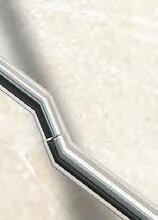










































Tires 816756 $45.99 each










Personalized Super Sturdy Hammer Hammers have a way of walking o . Here’s one they can call their own. Hickory-wood handle. 16 oz., 13"L. 816350 $21.99





Personalized Extendable Flashlight Tool Light tight dark spaces; pick up metal objects. Magnetic 6¾" LED flashlight extends to 22"L; bends to direct light. With 4 LR44 batteries. 817098 $32.99



Our durable Lillian Vernon products are built to last. Each is crafted using the best materials and manufacturing methods. Best of all, we’ll personalize them with your good name or monogram. Ordering is easy. Shipping is free.* Go to LillianVernon.com or call 1-800-545-5426.







Personalized Grooming Kit

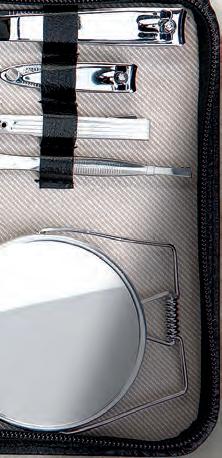

Indispensable zippered manmade-leather case contains comb, nail tools, mirror, lint brush, shaver, toothbrush, bottle opener. Lined; 5½x7".



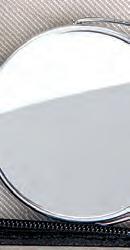
817548 $29.99


Personalized Beer Caddy Cooler Tote Soft-sided, waxed-cotton canvas cooler tote with removable divider includes an integrated opener, adjustable shoulder strap, and secures 6 bottles. 9x5½x6¾".
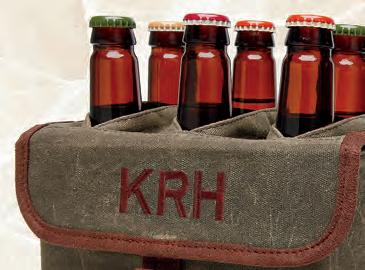
817006 $64.99
Personalized Bottle Opener Handsome tool helps top o a long day with a cool brew. 1½x7"W. Brewery 817820




Initial Family Name 817822 $11.99 each



Personalized 13-in-1 Multi-Function Tool
All the essential tools he needs to tackle any job. Includes bottle opener, flathead screwdriver, Phillips screwdriver, key ring, scissors, LED light, corkscrew, saw, knife, can opener, nail file, nail cleaner and needle. Includes LR621 batteries. Stainless steel.
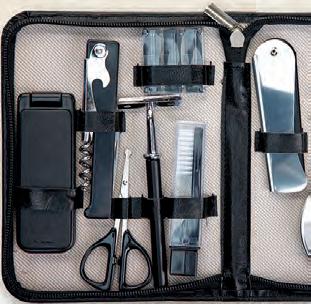
818456 $29.99

Seventy-five years ago allied airmen pulled off the Berlin Airlift, the most remarkable supply operation in history.
 By Don Smith
By Don Smith
German General Oskar von Hutier’s 1917 capture of the Baltic port debuted tactics still in use on battlefields.
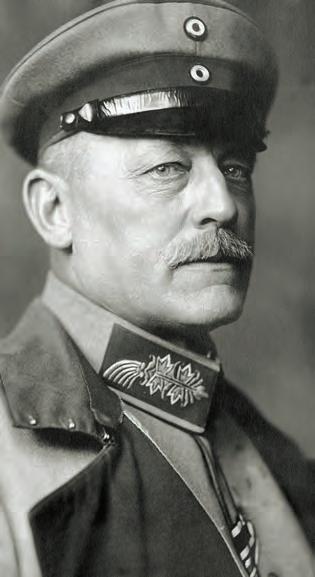 By David T. Zabecki
By David T. Zabecki

The successful 1704 French and Indian surprise raid on Deerfield, Mass., ultimately backfired on New France.
 By P.G. Smith
By P.G. Smith
In 1995 Peru and Ecuador waged a 34-day border war with Spanish colonial origins using the latest in high tech.

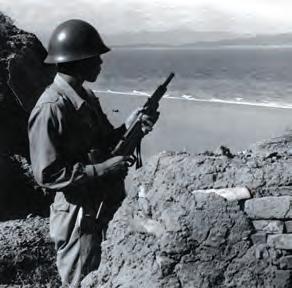 By Jerome Long
By Jerome Long
When commanders hired artists to depict their glory, they got what they ordered —just don’t look too closely.
 By Jon Guttman
By Jon Guttman
Nicknamed for his dogged determination, Major Patrick Ferguson very nearly earned fame for his namesake rifle.
 By John Miles
By John Miles
DAVID LAUTERBORN EDITOR
JON GUTTMAN SENIOR EDITOR
DAVID T. ZABECKI CHIEF MILITARY HISTORIAN
BRIAN WALKER GROUP DESIGN DIRECTOR
MELISSA A. WINN DIRECTOR OF PHOTOGRAPHY
JON C. BOCK ART DIRECTOR
ALEX GRIFFITH PHOTO EDITOR
DANA B. SHOAF EDITOR IN CHIEF
CLAIRE BARRETT NEWS AND SOCIAL EDITOR
CORPORATE
KELLY FACER SVP Revenue Operations
MATT GROSS VP Digital Initiatives
ROB WILKINS Director of Partnership Marketing
JAMIE ELLIOTT Senior Director, Production
ADVERTISING
MORTON GREENBERG SVP Advertising Sales mgreenberg@mco.com
TERRY JENKINS Regional Sales Manager tjenkins@historynet.com

DIRECT RESPONSE ADVERTISING
MEDIA PEOPLE / NANCY FORMAN nforman@mediapeople.com
© 2023 HistoryNet, LLC
SUBSCRIPTION INFORMATION: 800-435-0715 or SHOP.HISTORYNET.COM
Military History (ISSN 0889-7328) is published quarterly by HistoryNet, LLC, 901 N. Glebe Road, 5th Floor, Arlington, VA 22203
Periodical postage paid at Vienna, Va., and additional mailing offices
POSTMASTER , send address changes to Military History, P.O. Box 900, Lincolnshire, IL 60069-0900

List Rental Inquiries: Belkys Reyes, Lake Group Media, Inc. 914-925-2406; belkys.reyes@lakegroupmedia.com
Canada Publications Mail Agreement No. 41342519




Canadian GST No. 821371408RT0001
The contents of this magazine may not be reproduced in whole or in part without the written consent of HistoryNet, LLC
PROUDLY MADE IN THE USA
When 1982 rolled around, the U.S. Mint hadn’t produced a commemorative half dollar for nearly three decades. So, to celebrate George Washington’s 250th birthday, the tradition was revived. The Mint struck 90% silver half dollars in both Brilliant Uncirculated (BU) and Proof condition. These milestone Washington coins represented the first-ever modern U.S. commemoratives, and today are still the only modern commemorative half dollars struck in 90% silver!




These spectacular coins feature our first President and the Father of Our Country regally astride a horse on the front, while the back design shows Washington’s home at Mount Vernon. Here’s your chance to get both versions of the coin in one remarkable, 40-year-old, 2-Pc. Set—a gleaming Proof version with frosted details rising over mirrored fields struck at the San Francisco Mint, and a dazzling Brilliant Uncirculated coin with crisp details struck at the Denver Mint. Or you can get either coin individually.
No collection of modern U.S. coins is complete without these first-ever, one-year-only Silver Half Dollars—which effectively sold out at the mint since all unsold coins were


melted down. Don’t miss out on adding this pair of coveted firsts, each struck in 90% fine silver, to your collection! Call to secure yours now. Don’t miss out. Call right now!
1982 George Washington Silver Half Dollars
GOOD — Uncirculated Minted in Denver








2,210,458 struck Just $29.95 ea. +s/h
Sold Elsewhere for $43—SAVE $13.05
BETTER — Proof Minted in San Francisco



4,894,044 struck Just $29.95 ea. +s/h

Sold Elsewhere for $44.50—SAVE $14.55
BEST — Buy Both and Save!
2-Pc. Set (Proof and BU) Just $49.95/set


SAVE $9.95 off the individual prices
Set sold elsewhere for $87.50—SAVE $37.55
FREE SHIPPING on $49 or More! Limited time only. Product total over $49 before taxes (if any). Standard domestic shipping only. Not valid on previous purchases.
1-800-517-6468
Offer Code GWH138-01


Please mention this code when you call.


GovMint.com® is a retail distributor of coin and currency issues and is not affiliated with the U.S.
The unfortunate aircraft on the right is a more widespread success, the Douglas Boston, a twin-engine medium bomber that served with distinction on all fronts from Murmansk to Port Moresby with the U.S. Army Air Forces (as the A-20 Havoc), the RAF and Commonwealth, and the Soviet army and naval air forces.
got decent marks and were good at combat. Yet, both are bad-mouthed for actions they took in and out of war.
Would Military History run a good comparative article?
Morgan Little U.S. Navy Reserve (Ret.) Dripping Springs, TexasMy father was Royal Air Force Corporal Leonard John Henry Westbrook, and he was part of the No. 107 Maintenance Unit, stationed at RAF Kasfareet in Egypt. That air base was formed in late 1940 and originally called Geneifa. My father was stationed there, I believe, from 1941 to ’43, and he was a crane driver specializing in recovery and rescue of vehicles as well as planes. He drove most vehicles, from cranes to Queen Mary trailers, and his hunting grounds, so to speak, were Cairo, Sweetwater Canal, Alexandria, Port Tawfiq, Ismailia, Port Said, Suez and probably other places along the northern shores of Egypt and inland.
He took pictures of recovery operations of vehicles and planes, of general life in Egypt as well as of the air base, buildings and ships on the way out to Egypt. He used to send the pictures back to my mother, hidden in boxes marked Cosmetics . The day after he picked up the last batch of photos, the MPs raided the shop and confiscated everything, so he was really lucky, or rather the family was.
However, my father, despite continuous nagging from myself, always managed to find something else better to do then to record details on the backs of a good portion of the photos he had. Can you help me solve the riddle of these damaged planes?
Prue Westbrook Dunstable, U.K.
Senior editor Jon Guttman replies: The relatively intact one on the left is a Martin 187 Baltimore, a twin-engine light bomber that was tested for the U.S. Army Air Corps as the A-23 (and later the A-30), but was rejected. The British liked it, though, and it became the second most produced Martin design of World War II (after the B-26 Marauder), with 1,575 built. They served very well over North Africa and the Mediterranean from late 1941 on with the Royal Air Force and Royal Australian, Royal Canadian, South African, Royal Hellenic, Free French, Italian Co-belligerent and Turkish air forces. Despite their overall success within their area of operations, no intact examples are known to exist.
I believe these two were separately brought to 107 MU for either repair (likely for the Martin) or salvage (more likely for the Boston). It is possible the Boston collided with something on the field during a hot landing. On the English Channel front it was customary for Commonwealth squadrons to be identified by two letters on the fuselage sides, with a third letter for the individual plane —a practice emulated by the American Eighth and Ninth air forces, based in Britain. Over the desert and the Med, however, squadrons often painted over the squadron letters, leaving only the individual one, to fool the Germans (and, unfortunately in this case, posterity).
 By George
By George
I appreciate your magazine, in that the history of warfare has no limits. Good job!
Two controversial characters in U.S. Army history bear comparison: George A. Custer and George S. Patton. Both came from comfortable homes and families. Both received great reviews for their actions while progressing from commissioning to senior officer status. Military fitness reports determine a member’s later career success. Both, when fairly assessed,
Editor responds: Thank you for the suggestion. Custer and Patton were certainly polarizing figures, many military history aficionados either loving or hating them. The comparisons extend further. Both were graduates of the U.S. Military Academy at West Point —Custer graduating last in the Class of June 1861, Patton a lackluster 46th out of 103 in the Class of 1909. Both served in the American West—Custer during the 19th century Indian wars, Patton having participated in the 1916–17 punitive expedition to Mexico in search of Pancho Villa. And, yes, both gained notoriety for headlinegrabbing incidents. Custer was court-martialed and suspended for a year without pay in 1867–68 for having gone AWOL to visit wife Elizabeth during a cholera epidemic. On two separate occasions in August 1943, at field stations in Italy, Patton slapped shellshocked soldiers he suspected of cowardice. He was privately reprimanded by his superior, General Dwight D. Eisenhower, and ordered to apologize to each soldier.
to militaryhistory@historynet.com
Please include name, address and phone number
@MilitaryHistoryMagazine

Where does hunting fit in the modern world? To many, it can seem outdated or even cruel, but as On Hunting affirms, hunting is holistic, honest, and continually relevant. Authors Lt. Col. Dave Grossman, Linda K. Miller, and Capt. Keith A. Cunningham dive deep into the ancient past of hunting and examine its position today, demonstrating that we cannot understand humanity without first understanding hunting.
Readers will…
• discover how hunting formed us,
• examine hunting ethics and their adaptation to modernity,
• understand the challenges, traditions, and reverence of today’s hunter,
• identify hunting skills and their many applications outside the field,
• learn why hunting is critical to ecological restoration and preservation, and



• gain inspiration to share hunting with others.
Drawing from ecology, philosophy, and anthropology and sprinkled with campfire stories, this wide-ranging examination has rich depths for both nonhunters and hunters alike.

On Hunting shows that we need hunting still—and so does the wild earth we inhabit.


“All true hunters ‘feel’ the truth, but few are able to ‘articulate’ that truth. Now, thankfully, we have On Hunting to be our champion of the wild!”
—JIM SHOCKEY, Naturalist, Outfitter, TV Producer and HostBy Dave Kindy
On June 18, 1965, in the wake of a successful raid on a Viet Cong command post, U.S. Army Captain Paris Davis’ assault force of three fellow Green Berets and a company of South Vietnamese troops were counterattacked by enemy forces. At one point, with men wounded and dying all around him, the 5th Special Forces Group team commander was ordered to evacuate the battlefield.

“Sir, I’m just not going to leave,” Davis told his superior officer. “I still have an American out there.”
In 1965 then Captain Paris Davis rallied his men in a 19-hour firefight with Viet Cong.
Throughout the 19-hour battle Davis kept in the fight. Under intense enemy fire and shrugging off his own wounds, he organized the defense of his position, dragged fellow Green Berets to safety and refused to leave until all friendly forces had been recovered or evacuated. Among the first black officers in the Special Forces, Davis received the Silver Star and Purple Heart for his actions. Though he was twice nominated for the Medal of Honor, the paperwork vanished each time, leading to suggestions of racism. All the while, those who had fought alongside Davis insisted he receive the Medal of Honor.
“We all knew he deserved it then,” said Ron Deis, one of the Green Berets in that battle. “He sure as hell deserves it now.”
Davis finally got his due on March 3, 2023, when the retired colonel received the Medal of Honor from President Joe Biden in a White House ceremony.
SOUND OFF

‘This will remain the land of the free only so long as it is the home of the brave’ —Elmer Holmes Davis, director of the U.S. Office of War Information during World War II

June 1, 1776
Patrick “Bulldog” Ferguson (P. 64), a Scottish officer in the British army, demonstrates his breechloading namesake rifle. He earns his “dogged” nickname for his reckless courage and determination during the American Revolutionary War.
June 19, 1948
Officials in Soviet-occupied Germany initiate a systematic blockade of all roads, rivers and rail routes to isolated West Berlin, presaging the start of the Berlin Airlift (P. 24).
June 30, 1722
In 1923 the U.S. Army Air Service at McCook Field in Dayton, Ohio, put a few biplane engines and other machinery on public display. That modest effort launched the genesis of the presentday National Museum of the United States Air Force, whose exhibit space at Wright-Patterson Air Force Base spans more than 1.1 million square feet and features some 350 vehicles and missiles and thousands of artifacts. The world’s oldest and largest military aviation museum is marking its centennial with a series of exhibits, including ones honoring its history, enlisted personnel and search-and-rescue operations.

Grant
aide.
Jean-Baptiste Hertel de Rouville dies on Île-Royale, New France (present-day Cape Breton Island, Canada). In 1704 Hertel led French and Indian troops 300 miles on the bloody Deerfield Raid (P. 48) in the English Province of Massachusetts Bay.
July 18, 1868
German-American painter Emanuel Leutze—famed for his moving, albeit inaccurate, Washington Crossing the Delaware dies in Washington, D.C. His and other faulty works are the subject of this issue’s Portfolio (P. 42).
July 28, 1990
it out
do the other thing. But not to decide wastes both time and money and may ruin everything.” As commanding general of the Union Army during the Civil War, Grant made key decisions that brought the North victory at a precarious time in the nation’s history. As part of the 2023 National Defense Authorization Act, Congress has recognized the decisive commander and 18th U.S. president with a posthumous promotion to General of the Armies, an honor conferred only three times. Grant shares the Army’s highest rank with George Washington and John J. Pershing.
Alberto Fujimori is elected president of Peru. He remains at the helm in 1995 when Ecuador invades, sparking a 34-day border clash known as the Cenepa War (P. 56).
Aug. 27, 1857
Oskar von Hutier is born in the Prussian province of Saxony. In 1917 the German general displays his tactical genius during the Battle of Riga (P. 34), which effectively knocks Russia out of World War I.
“In war anything is better than indecision,” Ulysses S.
once told an
“We must decide. If I am wrong, we shall soon find
and can
Much like contemporary soldiers, Romans didn’t enlist to line their pockets. Proof comes in the form of a legionary’s papyrus paycheck dating back nearly 2,000 years. Israeli archaeologists recently turned up the relic at the ruins of Masada (above), site of the infamous ad 72–73 siege against Jewish rebels that ended with the latter’s mass suicide. According to the pay stub—one of only three known to survive from the ancient world—the legionary earned next to nothing after deductions for a tunic, footwear and fodder for his horse. The find lends new credence to verses from the 1917 World War I ditty: “You’ll never get rich by digging a ditch / You’re in the Army now.”

In 1917 a War Department memorandum authorized regional U.S. Army commanders in Southern states to name newly created camps after Confederate commanders. Though intended to foster reconciliation, the practice proved controversial then and remained so. No less contentious was the recent decision by the Defense Department to rename those installations. While some argue the move is an attempt to erase history, others stress the need to have the nation’s military assets reflect all Americans’ ideals. “The names of these installations and facilities should inspire all those who call them home, fully reflect the history and the values of the United States, and commemorate the best of the republic that we are all sworn to protect,” Defense Secretary Lloyd J. Austin III said on announcing the changes last fall. The department will change the names of more than 1,100 assets, notably the following:
ALABAMA Fort Rucker to Fort Novosel for Medal of Honor recipient
CW4 Michael J. Novosel.
GEORGIA Fort Benning to Fort Moore for Lt. Gen. Hal Moore and wife Julia; Fort Gordon to Fort Eisenhower for 34th President and General of the Army Dwight D. Eisenhower
LOUISIANA Fort Polk to Fort Johnson for Medal of Honor recipient Sergeant William Henry Johnson
NORTH CAROLINA Fort Bragg to Fort Liberty to honor American values

TEXAS Fort Hood to Fort Cavazos for Gen. Richard E. Cavazos
VIRGINIA Fort A.P. Hill to Fort Walker for Medal of Honor recipient Dr. Mary Edwards Walker; Fort Lee to Fort Gregg-Adams for Lt. Gen. Arthur J. Gregg and Lt. Col. Charity (née Adams) Earley; and Fort Pickett to Fort Barfoot for Medal of Honor recipient Tech. Sgt. Van T. Barfoot
Ben Ferencz (seated below left) was only 27 when he stood up in court against Nazi war criminals on behalf of the U.S. Army in 1947. At 102, he’s now the last living Nuremberg prosecutor. “War making itself is the supreme international crime against humanity,” he once said, “[and] should be deterred by punishment universally, wherever and whenever offenders are apprehended.” Congress recently honored Ferencz’s lifelong advocacy of peace and the rule of law with a Congressional Gold Medal, its highest expression of appreciation.

New research suggests severe drought in eastern and central Europe triggered the 5th century barbarian invasions of the Western Roman empire. According to the study published in the Journal of Roman Archaeology, arid conditions on the Danube frontier from the 430s to 450s likely devastated crops and cattle, prompting the Huns and allied barbarian tribes to push south and west and take on the power of Rome. “We found that periods of drought recorded in biochemical signals in tree rings coincided with an intensification of raiding activity in the region,” said co-author Ulf Büntgen of the University of Cambridge. During his concurrent 434–453 reign Atilla the Hun led major invasions into northern Italy and to the gates of Constantinople (present-day Istanbul, Turkey). The Western Roman empire ultimately collapsed in 476.


On May 4, 1917, more than 200 German soldiers set out for the front at Chemin des Dames, France, amid the Second Battle of the Aisne. As they passed through a nearly 1,000-foot-long shortcut known as the Winterberg tunnel, a coordinated French artillery barrage hit both ends of the passageway, sealing inside all but three of the Germans. Many of those trapped died from suffocation or thirst. Others resorted to suicide, as rescue was impossible.
Earlier this year, after fruitless efforts to recover remains, the German and French governments instead deemed the site a war memorial. “This guarantees that the soldiers will continue to rest in peace,” said a spokesperson for Volksbund, the German war graves commission.
A postwar Australian-built and -restored CAC Mustang again took to the skies—appropriately enough on Australia Day 2023. A variant of the North American P-51D, the former Royal Australian Air Force CA-18 rolled off the Commonwealth Aircraft Corp. assembly line in Melbourne in 1947. It had been undergoing restoration by the family of the late aircraft collector Bob Eastgate since 2008.

The British auction house Silverstone has listed a restored 1942 Ford GPW with only 18,550 miles on its odometer. That year the jeep carried King George VI and General Carl Spaatz, wartime commander of Strategic Air Forces in Europe, on a visit to RAF Chelveston airfield. Asking price is a relatively modest £38,850 (just shy of $50K).

TAPS Vaccaro
Tony Vaccaro, 100, a U.S. Army infantryman and combat photographer in World War II, died on Dec. 28, 2023, in Long Island City, N.Y. After capturing searing images of U.S. soldiers fighting across Europe, he became a fashion and lifestyle photographer for Life and other magazines.
Robert Hébras, 97, the last living survivor of the German massacre of civilians in Oradour-sur-Glane, France, in World War II, died on Feb. 11, 2023, in Saint-Junien, France. On June 10, 1944, Waffen-SS troops slaughtered 643 unarmed townspeople in retribution for resistance activity. A teen at the time, Hébras lay hidden beneath corpses before fleeing to a stable.
Gary L. Harrell, 71, a retired major general and the Delta Force commander at the 1993 Battle of Mogadishu in Somalia, died Feb. 14, 2023, in Jonesborough, Tenn. Despite suffering severe wounds, Harrell kept fighting and saved the lives of other wounded during the clash that inspired the book and film Black Hawk Down.
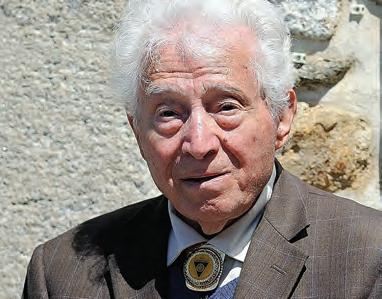
Own two exclusive uncirculated US half dollars enhanced by Mystic to honor the Korean War. Worth $19.98, they’re yours for only $5! Plus you get FREE shipping and guaranteed delivery.
Available Only from Mystic – SAVE $14.98
One coin honors the most decorated Marine in US history, Lieutenant General “Chesty” Puller. The photo was taken in 1950 when Puller commanded the 1st Marine Division. The other coin pictures a soldier at the 38th Parallel – the line that divided a country.
Strict Limit of One Offer
Send for your Korean War history coins today. You’ll also receive special collector’s information and other interesting coins on approval. Limit of five offers. Look for the MysticAd.com line on the order form.







❏ Yes! Send me the “Chesty” Puller and 38th Parallel Korean War half dollar history coins. Enclosed is $5.
Limit of five offers.
Quick order atMysticAd.com/CQ210
Name ________________________________________________
Address ______________________________________________ City/State/Zip _________________________________________



Get this complete mint set of US stamps honoring great American military leaders for only $3! Normally $8.75, you save $5.75.
Historic 1936-37 stamp set honors George Washington, Andrew Jackson, Ulysses S. Grant and more.





The 10-stamp set is yours in mint-fresh condition for only $3. Shipping and guaranteed delivery are FREE! You’ll also receive special collector’s information and other interesting stamps on approval. Strict limit of one set.

❏ Yes! Send my set of 10 US War Heroes mint stamps. Enclosed is $3. My satisfaction is guaranteed. Strict limit of one set.






Quick order at MysticAd.com/X354



Name ________________________________________________


Address ______________________________________________
Please send payment to: Mystic, Dept. CQ210, 9700 Mill St., Camden, NY 13316-9111
Please send payment to: Mystic Stamp, Dept. X354, 9700 Mill St., Camden, NY 13316-9111




You didn’t set out to be a medic. How did that transpire? Well, I volunteered for the infantry. After basic training they assigned me to Fort Sam Houston [in San Antonio, Texas], where there was a center to train all the medics. Wherever the Army is, of course, they have to have medical support, and so we wind up all over the place. I wound up with an infantry company as a combat medic.

Francis Whitebird hails from a long line of soldiers. His great-grandfather, grandfather and father all saw service in the U.S. Army dating back nearly 150 years. At the outset of the Vietnam War he honored that family legacy and the warrior tradition of the Rosebud Lakotas of South Dakota by enlisting. Whitebird endured 19 months of intense fighting as a combat medic in 1969 and ’70. After the war he graduated from Harvard, became a teacher, served in tribal government, received a presidential appointment to a national advisory committee and worked to preserve the Lakota language. He also raised two sons, Colin and Brendan, who carried on the family tradition by joining the Army and fighting in Iraq. At the 2022 National Memorial Day Concert in Washington, D.C., actors and co-hosts Gary Sinise and Joe Mantegna honored Whitebird in person for his service. Military History recently sat down with the 80-year-old veteran to learn more about his experiences and legacy of service.
When you’re assigned to an infantry company, you’re in charge of a platoon —about 40 men. In addition to wounds, you treat them for heat casualties, sores and other injuries. There’s something in Vietnam called elephant grass, and when you pass through it, it cuts into your arms. There’s other stuff like jungle rot and creeping crud. I don’t know their scientific names, but that’s what we called them. There’s also mosquitoes and leeches and whatnot.
Some men experienced malaria and sprains. Leg injuries were common, because we’d be up in the mountains, and people would twist their ankles. It’s a full-time job just to keep them healthy. Then you get into a firefight, and you have to drag them back, treat them and get them out of there.
You have to earn your Combat Medical Badge, just like the Combat Infantryman Badge. You have to serve at least two months in a jungle or get into four firefights, and then they give it to you. You earn it through longevity. I was assigned to the 196th Light Infantry Brigade as a platoon medic with Bravo Company for two months, then became company medic for Charlie Company, where I was in charge of three medics.
For the first nine months when I was the company medic for Charlie Company, we went through 27 medics. That was,
like, one medic per platoon per month killed or wounded. When somebody starts yelling, “Medic!” they’re counting on you. I don’t know why we do it. I guess we’re young and foolish and don’t know any better.
I remember the Battle of Hiep Duc. The fourth longest battle in Vietnam, it went for 13 days. Infantry companies were being rotated in and out. We had lots of casualties. That was in August of 1969—same time as Woodstock. That battle followed Hamburger Hill. I always thought, Why didn’t they just pull us back and B-52 the place? Some general probably wanted to earn another star. Anyway, at that battle there was a guy named Rocky Bleier, who later played for the Pittsburgh Steelers. He was wounded there. He has a great story about recovery and going into the NFL.
At Hiep Duc my company hit booby traps—they call them IEDs now. They were strung out along the top of the hill. We had 38 casualties, and my three medics went down. I collected all the morphine syrettes and started treating people. If one needed a shot of morphine, I gave him one and then just kept going. We were lucky there were no fatalities. After the third booby trap went off, I called for the “Dustoff”—that’s what we called the medevac helicopter. I put on the guy who set off the booby traps— his name was Marty, and he was from Vermont. He was filled with wounds. I had already given him a shot of morphine. As I was putting him on the chopper, he looked at me and said, “Doc, I’ll see you back in the world,” and gave me a peace sign. He was just smiling, because the morphine had kicked in. I did meet him again, at a reunion in St. Louis in 1988. And he came over with his family and told them, “This is the guy who saved me.” That means a lot when somebody does that. When people thank me for saving their lives, I tell them, “I’m
only one—there are nurses and doctors that take care of you too.” One of them said, “Yeah, but you’re the one who pulled me out of the line of fire.”
Tell us about your own experience of being wounded. I was hit by shrapnel from an RPG [rocketpropelled grenade]. A large sliver hit my side, and it burned like hell. It came in so hot, it cauterized the wound. I used clamps to pull out the shrapnel and threw it away. There was a big firefight at the time. I was running toward somebody who was wounded when I got hit. So I just put on a piece of tape to keep the dirt out and kept on going. Other people needed my help.
How did you deal with fear when helping the wounded amid a firefight?

Adrenaline kicks in. It takes over, and you don’t have that fear. You do what you’re trained to do—go in there and
get the guy out. I didn’t think about fear; I just thought about saving the guy. After the firefight adrenaline is still in your body. Sometimes, you’re just shaking from it. You think, Holy crap! I survived that! Then you go on to the next battle.
Of course, there’s always the possibility you could get killed. When I was in jungle training, this instructor said that in a firefight the longevity of an officer, RTO [radio telephone operator] or medic is about 90 seconds. I thought, Oh, no, I’m dead.
You must have been under incredible stress. How did you handle it?
Well, there’s only so much you can take. In that humidity and heat you could smell human blood. It gets on your hands, on your jungle fatigues. You don’t go back and take a shower. I think the longest we stayed in the jungle was 69 days. You just need to go day by day and survive. Don’t worry about the future.
One of the loneliest times was radio watch. Every half hour the men had to check in with a squelch on their radios so we knew they were awake. You’re lying there in between check-ins, and you think about home. You think about different things and how you should have done them. Some of the people were married, and some had girlfriends. Of course they think about them. There was nothing to do.
The worst times were when guys got a “Dear John” letter. Their minds weren’t right. In the next firefight they wanted to go out in a blaze of glory. We called it the “John Wayne syndrome.” It didn’t happen very often, but it happened. So, to get away from that, we’d send them to the rear, get them drunk a couple of days, and they’d come back feeling better.
Describe your Lakota family’s time-honored warrior tradition. One of my great-grandfathers was an Indian scout for Company E of the 2nd
U.S. Cavalry, and I have an uncle who was a World War I vet with the infantry. We [Lakotas of the Rosebud Indian Reservation] had, I think, 200 people serving in World War I when probably fewer than 5,000 people lived on the reservation. My uncle was with the American Expeditionary Force in Siberia.
In World War II my dad was a Lakota code talker. He took an oath that he could not tell anyone about it. Not like the Navajos in the Pacific. After World War II [the Navajo code talkers] were beating their chests and jumping up and down. There were about 30 tribes involved as code talkers in Europe then, and they all took an oath they could not tell anyone, because the United States might go to war with Russia.

Code talking started in World War I. There were zero Navajo code talkers and about 40 Lakota code talkers then. There
was even a team of code talkers in Korea. They never talked about it until 1968, when they lifted the ban. My dad told me then he was a code talker.
What was it like to receive public recognition at the 2022 National Memorial Day Concert?
To tell you the truth, I thought I was going to be among a whole bunch. I didn’t know I was one of two people being honored. I knew I was into something when they put us in the front row. My good friend from Vietnam, Paul Critchlow, was with me. He’s from Omaha, Neb., and was a paratrooper pathfinder.
How did Vietnam change your life?
Change came very slowly. First of all, I had to deal with PTSD, which I did by
running 5 miles a day. Then I went to Harvard for four years. It didn’t really sink in, though, until I attended a “rap group” at the VA. It was for combat people, and it was the first time I told stories about my combat experience to anyone. That really helped. The other thing that was helpful was something English speakers call a sweat lodge. It really should be called a prayer lodge, because that’s what you do. It cleanses your body but also cleanses your mind. Praying is primary, sweating secondary. When we started doing these prayer lodges, a lot of the combat people started coming in and getting better. You’ve got to let the stories out. I keep telling my kids, “Tell your story.”
Do you ever wonder how you survived Vietnam and so many other challenges?
You know, I’m a cancer survivor for 19 years—probably got it from Agent Orange—and, well, I’m doing okay. I’m still aboveground! MH










him and another in the tail section. With no word from the cockpit, the radioman and two waist gunners decided the plane was doomed and bailed out.
“The smoke and gas were really thick,” Smith recalled. “I wrapped a sweater around my face so I could breathe, grabbed a fire extinguisher and attacked the fire in the radio room. Glancing over my shoulder at the tail fire, I thought I saw something coming, and I ran back. It was the tail gunner, painfully crawling back, wounded. He had blood all over him.”
Sergeant Maynard Harrison “Snuffy” Smith was not your typical hero.

“From the time he entered the Air Force he had been in some kind of trouble over one petty matter or another,” wrote Army Pvt. Andy Rooney, then a Stars and Stripes correspondent. “‘Snuffy’ was, in fact, known by the 14 other inhabitants of his Nissen hut by an Army phrase for which there’s no socially acceptable replacement.” Smith was said to have earned the nickname “Snuffy” due to his general obnoxiousness and unwillingness to be a team player, traits he shared with the then-popular comic strip character Snuffy Smith.
By mid-1942 Smith, then 31 years old, had been married and divorced in his native Michigan and was behind in child support payments. A judge gave him a choice: Go to jail or enlist. Snuffy picked the latter and joined the Army Air Forces that August.
In part due to his slight stature, the 5-foot-6, 130-pound Smith qualified as a ball turret gunner on the Boeing B-17 Flying Fortress. But for six weeks after he’d been posted to the 306th Bombardment Group at RAF Thurleigh airfield in south-central England no crew would take the “undesirable” sergeant.
Finally, on May 1, 1943, Smith flew his first mission, against the German U-boat pens at Saint-Nazaire, France. The raid itself went well, but en route back to England the off-course B-17 formation strayed too close to German-occupied Brest and was immediately targeted by anti-aircraft fire and attacked by German fighters.
Hits to Smith’s bomber ruptured gas tanks, set its midsection ablaze, destroyed its internal communications and knocked out the electrical controls of the ball turret. Snuffy climbed up into the fuselage to find a massive fire in the radio room ahead of
Smith did what he could for the man, then returned forward to fire at the persistent German planes from the abandoned waist guns and fight the blaze. For 90 minutes he alternately tended the wounded tail gunner, fired the waist guns and tossed unexploded ammunition and all else flammable through holes in the fuselage. He contained the fire enough that the B-17 was able to limp back to the nearest airfield in England, though it broke in half when the tail wheel touched down. The ground crew counted more than 3,500 bullet and shrapnel holes in what remained of the bomber. One propeller was splintered, its flaps were destroyed, the radio room gutted, the left wing gas tank destroyed and its nose shattered.
Smith and the other five men still aboard the B-17 survived, but 75 fellow airmen who’d participated in the raid, including the three who had bailed out of Smith’s plane, had been killed or were missing, and another 15 were wounded.
On July 12 the men of the 306th gathered on the tarmac at RAF Thurleigh. With a band in place, 18 bombers ready for a flyover and two radio networks ready to broadcast, all that was missing was Smith. He was found on KP duty, scraping off breakfast trays. His mates soon had him cleaned up and escorted him to the tarmac, where Secretary of War Henry L. Stimson draped Snuffy Smith with a Medal of Honor. MH

● Easy One Touch Menu!
● Large Fonts
200% Zoom
Secure System No Viruses!
Speech to Text You talk, It types!
Great Customer Ratings
● Large Print Keyboard

● 100% US Support Copyright
If you find computers frustrating and confusing, you are not alone. When the Personal Computer was introduced, it was simple. It has now become a complex Business Computer with thousands of programs for Accounting,Engineering, Databases etc. This makes the computer complex.
You want something easy, enjoyable, ready to go out of the box with just the programs you need. That’s why we created the Telikin One Touch computer.
Telikin is easy, just take it out of the box, plug it in and connect to the internet. Telikin will let you easily stay connected with friends and family, shop online, find the best prices on everything, get home delivery, have doctor visits, video chat with the grandkids, share pictures, find old friends and more. Telikin One Touch is completely different.
One Touch Interface - A single touch takes you to Email, Web, Video Chat, Contacts, Photos, Games and more.

Large Fonts, 200% Zoom – Easy to see easy to read.
Secure System – No one has ever downloaded a virus on Telikin
Voice Recognition - No one likes to type. Telikin has Speech to Text. You talk, it types.

Preloaded Software - All programs are pre-loaded andset up. Nothing to download.
100% US based support – Talk to a real person who wants to help. Telikin has great ratings on BBB and Google!



This computer is not designed for business. It is designed for you!
"This was a great investment "
Ryan M,CopperCanyon, TX
"Thank you again for making a computer for seniors"
Megan M,Hilliard, OH
"Telikin support is truly amazing.”
NickV,Central Point, OR Call toll freeto find out more!
Mention Code 1214 for introductory pricing
60 Day money back guarantee
844-201-3918
On Oct. 1, 1949, Chinese Communist Party Chairman Mao Zedong declared the People’s Republic of China (PRC) the sole government of China. That December 7 Generalissimo Chiang Kai-shek and the leadership of the Republic of China (ROC) fled to the island of Taiwan. They, too, soon claimed to be the sole legitimate government of China. Thus, the stage was set for a series of military confrontations in the Taiwan Strait.
The first crisis occurred in 1954–55 and centered on the PRC seizure of small island groups offshore from Zhejiang (Chiang’s home province) that were under ROC military control. It began when the PRC shelled the ROC-controlled island of Kinmen (aka Quemoy). In January 1955 PRC forces seized the Yijiangshan Islands. That action prompted the U.S. Congress to enact the Formosa Resolution, authorizing the use of American military force to defend Taiwan against further PRC military thrusts. In its wake the U.S. Navy facilitated the ROC evacuation of the Dachen Islands, while the Pentagon contemplated the use of nuclear-tipped missiles on behalf of the ROC.
The second crisis, in 1958, also involved islands just offshore from Zhejiang. This time the PRC established an artillery blockade of Kinmen, which forced seaborne and aerial drops of food and supplies to its defenders. The United States deployed significant air and naval forces into the Taiwan Strait and again considered the use of nuclear weapons.
The third crisis arose in 1995–96 when the PRC mobilized its armed forces in Fujian and conducted missile tests and live-fire naval exercises in the Taiwan Strait, disrupting commercial shipping near the Taiwanese ports of Keelung and Kaoshiung. Unlike the first crises, the PRC’s actions were in protest to then ROC President Lee Teng-hui’s moves toward a democratic and politically independent Taiwan—an idea wholly abhorrent in the minds of Beijing’s leaders. American warships, including two carrier battle groups, transited the Taiwan Strait, but the crisis eventually abated.
Just why the PRC risked a nuclear response from the United States in the 1950s over a handful of small island groups in the Taiwan Strait is instructive.
Essentially, Beijing exploited the first two military crises with Taiwan to convince the Soviet Union of the PRC’s immediate need for Russian nuclear weapons technology and advisers. This was followed up by a decision at the highest political ranks in Beijing to devote considerable financial resources and manpower into making the PRC a nuclear power as rapidly as possible. On Oct. 16, 1964, the PRC successfully detonated its first nuclear device, of approximately the same yield as the one the United States used against Nagasaki in 1945 and the one detonated by Russia in 1949 during its first nuclear weapon test. Thus, the PRC manipulated both the United States and the Soviet Union to achieve nuclear parity by engaging in relatively minor military actions in the Taiwan Straits.
Look through the bluff. Throughout the Cold War, even during the hot wars on the Korean Peninsula and in Vietnam, the PRC never attempted a full-scale invasion of Taiwan. The mere threat, however, contributed to another achievement—nuclear parity with the superpowers. Tigers don’t change their stripes. Less than a decade after the PRC’s founding its leaders were politically savvy enough to use the Taiwan Strait Crises to wring all necessary technology from the Soviet Union to build their own nuclear bombs. Beijing still uses this manipulative approach to advance its international ambitions. Remain vigilant. In the 74 years since its inception the PRC has not budged from its intentions with regard to Taiwan—unification. How it aims to accomplish that is an open question. MH

AUGUST 26, 1814
BROOKEVILLE, MARYLAND, BECOMES
“U.S. CAPITAL FOR A DAY” WHEN PRESIDENT JAMES MADISON TAKES REFUGE THERE.

EARLIER THAT WEEK, BRITISH TROOPS
HAD SET FIRE TO WASHINGTON, INCLUDING THE WHITE HOUSE AND CAPITOL BUILDING. MADISON FLED THE CITY, ALONG WITH MEMBERS OF HIS CABINET, AND SPENT THE NIGHT OF THE 26TH AT THE HOME OF BROOKEVILLE POSTMASTER CALEB BENTLEY. THE TOWN STILL CELEBRATES THE EVENT EACH YEAR.
For more, visit HISTORYNET.COM/TODAY-IN-HISTORY
 By Jon Guttman
Illustration by Chris Davey
By Jon Guttman
Illustration by Chris Davey
In 1932 the Aeronautics Branch of the U.S. Commerce Department issued a requirement for a safer monoplane air transport, which Boeing first satisfied with its Model 247. Aircraft designer Donald Wills Douglas soon outclassed all comers with his more advanced designs, including a prototype DC-1, the improved DC-2 and the Douglas Sleeper Transport (DST), with a rounded, more capacious fuselage capable of carrying up to 16 overnight passengers or 24 daytime riders. The DST first flew on Dec. 17, 1935. It and its 21-seat nonsleeper variant, the DC-3, revolutionized air transport as the first truly profitable airliners.
During World War II Douglas militarized DC-3s with cargo doors, hoist attachments and a strengthened floor. Designated C-47 Skytrains by the U.S. Army, Dakotas by the British Royal Air Force and Lisunov Li-2s by the Soviets (who built them under license), they became mainstays of
Allied cargo and troop transport. Each plane could carry 28 fully equipped troops or up to 6,000 pounds of cargo, including a jeep or an M3 37 mm antitank gun. More than 10,000 C-47 variants were built.
After the war a new generation of faster four-engine airliners eclipsed the DC-3 on the transoceanic routes, but its war surplus numbers, outstanding safety record and overall performance kept it useful as a medium-range feeder liner for decades thereafter. Most of the transports used in the 1948–49 Berlin Airlift (see P. 24) were Skytrains of the Military Air Transport Service and RAF Dakotas. The U.S. military continued to use the airframe well into the 1970s in a variety of roles, including as the lethal AC-47D Spooky gunship in Vietnam. MH
10
11
12
13
14
15
16
Specifications:
Crew: Four (pilot, copilot, navigator, radio operator)

Capacity: 28 fully loaded troops or 6,000 pounds of cargo
Wingspan: 95 feet 6 inches
Wing area: 987 square feet
Length: 63 feet 9 inches
Height: 17 feet
Empty weight: 17,865 pounds
Max takeoff weight: 31,000 pounds
Power: Two Pratt & Whitney Twin Wasp R-1830-92 1,200 hp 14-cylinder air-cooled radial piston engines

Maximum speed: 224 mph
Service ceiling: 26,400 feet
Maximum range: 3,600 miles
Recalling the Berlin Airlift 75 years after the launch of the most remarkable supply operation in human history
 By Don Smith
By Don Smith
In what became an enduring image of the 1948–49 effort to supply blockaded West Berlin, children line a fence bordering Tempelhof Field, in the American sector, as a transport plane comes in for a landing.

On Friday the 13th of August 1948 U.S. Air Force Lt. Col. Sterling P. Bettinger tried to land his Douglas C-54 Skymaster transport at Berlin’s Tempelhof Field. Aboard was a VIP passenger—Maj. Gen. William H. Tunner, the new director of operations for the seven-week-old Berlin Airlift. Unfortunately, recalled Tunner in his memoir Over the Hump, “at that moment everything was going completely to hell in Berlin. The ceiling had suddenly fallen in on Tempelhof. The clouds dropped to the tops of the apartment buildings surrounding the field, and then they suddenly gave way in a cloudburst that obscured the runway from the tower. The radar could not penetrate the sheets of rain.” One aircraft crashed; another blew out its tires braking to avoid the crash.
Bettinger joined a cluster of pilots circling over Tempelhof, waiting as ground controllers tried to sort out the mess. “The pilots filled the air with chatter, calling in constantly in near panic to find out what was going on,” Tunner recalled. “On the ground a traffic jam was building up as planes came off the unloading line…but were refused permission to take off for fear of collision with the planes milling around overhead. ‘This is a hell of a way to run a railroad,’ I snarled.”


Two months earlier the Cold War had heated up dramatically. Unhappy with plans by the Western Allies (France, Britain and the United States) to create a federal government uniting the portions of Germany they occupied, the Soviet Union in retaliation blockaded the American, British and French occupation sectors in isolated West Berlin. On June 19 the Russians blocked automotive and rail passenger service between western Germany and Berlin. On the 24th they halted all barge and rail freight shipments, cutting the primary supply and commerce links for more than 2 million Berliners. The only means left to the Western Allies to sustain the city was by air transport. “Members of the Soviet military administration in Germany celebrated when the blockade began,” wrote U.S. Air Force historian Roger Miller. “None had doubts that the blockade would succeed.” Major General Lucius Clay, military governor of
the American occupied zone of Germany, recalled the Russians were “confident that it would be physically impossible for the Western Allies to maintain their position in Berlin.” The chaos Tunner and Bettinger encountered at Tempelhof seemed to validate Soviet confidence the airlift would fail. A year later, though, it was the Western Allies who were celebrating. Between June 26, 1948, and Sept. 30, 1949, Allied transport planes completed 277,569 cargo flights, carrying 2,325,509 tons of supplies, into West Berlin. West Berliners had suffered a great deal, but they had endured, and the Western Allies’ position in the divided city had remained strong. On May 12, 1949, the Russians threw in the towel and reopened land and water access to the western sectors— without receiving any concessions regarding the formation of a West German government. (The airlift continued through September to build up emergency supply stocks in Berlin.)
The airlift achieved what many thought was impossible: fulfilling the critical needs of a modern city’s population solely through air transport. Allied determination and organization had won the West’s first major victory in the Cold War.
On June 28, four days after the blockade began, the U.S. Departments of State and Defense briefed President Harry S. Truman on the situation. Miller, in his book To Save a City, notes the president quickly quashed any idea of withdrawal. “Abandoning Berlin, [Truman] affirmed, was beyond discussion,” Miller wrote. “The United States was in Berlin by agreement, and the Soviets had no right to push its forces out.”
British Foreign Minister Ernest Bevin agreed. A former truck driver and union official, Bevin was the opposite of the stereotypical sophisticated English diplomat. Bevin had displayed his less-than-genteel manner at the July 1946 Paris Peace Conference. Soviet Foreign Minister Vyacheslav Molotov had hurled insults at the British during the meetings and continued the badgering at dinner one night. “Bevin exploded in rage,” wrote Giles Milton in his book Checkmate in Berlin. State Department official Charles Bohlen recalled Bevin “rose to his feet, his hands knotted into fists, and started toward Molotov, saying, ‘I’ve had enough of this, I ’ave.’ For one glorious moment it looked as if the foreign minister of Great Britain and the foreign minister of the Soviet Union were about to come to blows.” (Security intervened, defused the situation and spoiled the moment.) When the Soviets blockaded Berlin, Bevin demanded the Western Allies stand firm. Milton quotes him as saying he “did not want withdrawal to be contemplated in any quarter.” Ordered to stay in Berlin, the American and British military had to figure out how to maintain their position there.
Hardly any Western officials thought an airlift could satisfy Berlin’s needs for an extended period. “Rather it was a stopgap measure,” Miller wrote, “an expedient that enabled Western leaders to buy the time…to negotiate without either the need to give in at some point to Soviet pressure or to escalate the situation beyond control.”
A 1945 agreement between the wartime Allies established six corridors for aircraft travel to and from Berlin— three from the Soviet occupation zone, two from the British and one from the American. The Russians, loath to provoke armed conflict, didn’t contest the three western corridors. Anyway, they thought the airlift would fail. Before the blockade Berlin imported approximately 12,000 tons of supplies a day. American, British and French occupation officials calculated that West Berlin’s population, Western Allied personnel and their families would require a minimum of 4,500 tons daily to survive, while at most Royal Air Force and U.S. Air Force transport aircraft in Europe could carry 1,000 tons a day. West Berlin was not wholly sealed off from the outside world. It still received supplies from the Soviet zone, but not nearly enough to survive.
Clay added his voice to Truman’s and Bevin’s, arguing forcefully for the West to do whatever necessary to stay in Berlin. On June 25 Clay warned Army leadership that the
Top: In the aftermath of the Soviet blockade British authorities moved to demarcate the boundaries of their occupied sector of West Berlin. Above: Any cooperation exhibited at the 1945 Potsdam Conference by erstwhile Allies Joseph Stalin and Harry S. Truman gave way to distrust by 1948.


West’s credibility in Germany could be mortally wounded if they abandoned the western sectors. “Thousands of Germans have courageously expressed their opposition to Communism,” he told them. “We must not destroy their confidence by any indication of departure from Berlin.”
During World War II Clay had established a reputation in the Pentagon as a logistical and managerial wizard. When
supplies for Allied forces in Europe had backed up in the freshly liberated port at Cherbourg, Clay unsnarled the mess. That gravitas helped Clay convince others the Western Allies could supply all of Berlin’s needs by air. In late July he advised Washington that if it sent larger cargo aircraft, and many more of them, the U.S. and British aircrews could fly enough missions each day to keep West Berlin alive. Air Force leadership had serious doubts, as satisfying Clay’s wishes would leave it with few cargo aircraft for its growing list of missions worldwide. Regardless, Air Force Chief of Staff Hoyt Vandenburg affirmed that if Washington committed itself fully to the mission, Berlin could be supplied by air. Truman gave the go-ahead, and Clay got his resources.

Authorized by Congress on July 20, 1949, the Medal for Humane Action recognized any service member who performed at least 120 days of duty in direct support of the Berlin Airlift. It depicts a Douglas C-54 Skymaster over a wheat wreath and the coat of arms of Berlin.
The Americans and British had actually been airlifting cargo into West Berlin since April. That month the Soviets had imposed restrictions on Western Allied rail travel to West Germany. Considering it an omen of traffic disruptions to come, the Western Allies started stockpiling food and coal in West Berlin. Some of those supplies came by air in an operation dubbed the “Little Lift.”
When the Soviet blockade started in June, U.S. and British cargo planes ramped up that air operation. But the primary cargo airframe in the European theater was the Douglas C-47 Skytrain (see P. 22). Most were World War II leftovers, some still bearing their
black-and-white D-Day invasion stripes. At most the twin-engine C-47 could carry little more than 3 tons.
The four-engine C-54 Skymaster, on the other hand, could carry more than 13 tons of cargo. Thus, the Air Force started deploying C-54 squadrons from bases around the world to western Germany. (The Navy also provided two squadrons.) Many flew to Germany with only hours’ notice. Lieutenant Gail Halvorsen (see sidebar, P. 32), a C-54 pilot deployed from Alabama, recalled landing in Rhein-Main Air Base near Frankfurt with a contingent of Skymaster pilots and crewmen. Within two hours one of those crews was flying a plane to Berlin. Eventually, 225 C-54s were assigned to the airlift.
The airlift received new leadership—Tunner, who arrived in Germany on July 28. He would command the Combined Airlift Task Force (CALTF), an ad-hoc combined command that would coordinate and direct U.S. and British airlift operations. He’d already earned the nickname “Tonnage Tunner” for having led U.S. airlift operations over the Himalayas (the “Hump”) into China during World War II. Renowned as an air transport expert, he helped create the Army Air Forces Ferrying Command. He’d been watching the early stages of the Berlin Airlift from Washington. When Truman resolved to intensify the effort, Tunner got his chance.



The early days of the airlift were dramatic. Newspapers and news broadcasts ran stories of pilots rushing out to cargo aircraft parked haphazardly around their airfields and zooming off with them into the German skies. To readers and viewers worldwide it looked inspiring and dramatic. Yet to Tunner it reeked of inefficiency. (Halvorsen described the early days as a “real cowboy” operation.) “The actual operation of a successful airlift is about as glamorous as drops of water on stone,” said Tunner, in Over the Hump:
There’s no frenzy, no flap, just the inexorable process of getting the job done. In a successful airlift you don’t see planes parked all over the place; they’re either in the air, on loading or unloading ramps, or being worked on.
You don’t see personnel milling around; flying crews are either flying or resting up so that they can fly again tomorrow. Ground crews are either working on their assigned planes or resting up so that they can work on them again tomorrow.
“Under Tunner,” wrote Miller, “the monotony of repetition replaced the romance of flying.” Tunner set out to organize the airlift in exacting detail and refine it into a smooth, efficient operation.
In the first few months of the airlift chaos was not uncommon in the skies directly over Berlin. Aircraft from eight different airfields in Germany converged on just two in Berlin—Tempelhof, in the American sector, and RAF Gatow, in the British sector. When poor weather or problems on the ground made it difficult to land, planes would end up “stacked,” circling at different altitudes as they waited.
Tunner ended up in one of those stacks over Tempelhof, in cloudy weather and heavy rains, on that “Black Friday” August 13 flight to Berlin. “A huge, confusing, milling mass of aircraft circled in a stack from 3,000 to 12,000 feet,” wrote Miller, “in danger of collision or of drifting out of the corridors completely.”
Tunner radioed Tempelhof tower: “This is 5549, Tunner talking, and you better listen. Send every plane in the stack back to its home base.” Afterward, Tunner implemented new landing procedures for the Berlin airfields. If an aircraft missed its landing approach, it wouldn’t circle and try again; it would return to western Germany. Such was a far safer and more efficient way to manage landing operations. Air traffic controllers were no longer tasked with inserting stray aircraft back into the landing pattern; they could focus instead on managing a steady stream of incoming planes. “In the same 90 minutes it took to bring in nine aircraft stacked over Berlin,” Miller wrote, “the airlift could land 30 C-54s carrying 300 tons using the straightin approach and landing at three-minute intervals.”
Airlift controllers closely managed the ways planes flew in the corridors. They used time spacing to separate the aircraft, usually in three- to six-minute intervals. Aircraft announced the times they passed key radio beacons. Each aircraft crew knew the tail numbers of the three aircraft in front of and behind them. When they heard an aircraft announce its position, they would adjust their speed or heading to keep their proper place in the airflow. Any plane that lost radio communications or couldn’t keep its place in the flow had standing orders to fly home.
Pilots flew by instrument flight rules, even if the weather was good. Traffic in the corridors was one-way. The British used six airfields, and all sent their aircraft to Berlin through the northern airlift corridor, which originated north of Hamburg. The Americans flew from bases at Rhein-Main and Wiesbaden through the southern corridor. All aircraft
Above left: The scope of Operation Vittles was readily apparent. Above: West Berliners watch as flour descends from the belly of a Douglas C-74 Globemaster. Such encounters served to dispel any lingering hostilities.

returned to western Germany through the central corridor, which emptied near Hannover.
Tunner realized he couldn’t increase tonnage by adding more aircraft to the airlift. Washington had only so many planes to send, and the traffic patterns in the air corridors and parking aprons at the airfields were already full. So, he looked for other ways to maximize cargo throughput. The northern corridor was shorter than the southern, so planes that used it could fly more round trips per day. The American C-54s could carry more cargo than the C-47s and other aircraft the British were using, so Tunner stationed some American squadrons in the British zone. The USAF stripped unnecessary equipment (such as the LORAN long-range navigation systems) out of the C-54s to enable them to carry more cargo.
The more time a plane spent on the ground, the less cargo it could carry to Berlin. CALTF planners examined every step in the loading/ unloading process, looking for ways to cut time, increase safety margins and improve overall performance. Logistics planners realized that if multiple pieces of equipment were used to load aircraft, that added time to the loading process (and increased chances an errant forklift could damage a plane). CALTF switched to putting a plane’s cargo load on just one truck. The truck driver would shadow the Follow Me jeep that guided a newly landed plane to its parking spot. As the crew shut down its engines, German workers would jump from

BOEING C-97
STRATOFREIGHTER
CONSOLIDATED B-24
LIBERATOR
CONSOLIDATED PBY CATALINA
DOUGLAS C-47 SKYTRAIN and DOUGLAS DC-3
DOUGLAS C-54 SKYMASTER and DOUGLAS DC-4
DOUGLAS C-74 GLOBEMASTER
FAIRCHILD C-82 PACKET
LOCKHEED C-121A
CONSTELLATION
AVRO LANCASTER
AVRO LINCOLN
AVRO YORK
AVRO TUDOR
AVRO LANCASTRIAN
BRISTOL TYPE 170 FREIGHTER
DOUGLAS DC-3 (DAKOTA)
HANDLEY PAGE HASTINGS
HANDLEY PAGE HALIFAX
SHORT SUNDERLAND
VICKERS VC.1 VIKING
nder a 1945 agreement the erstwhile wartime Allies in occupied Germany established six corridors for air travel in and out of Berlin, in Soviet-occupied eastern Germany. During the 1948–49 airlift the two corridors from the British sector and one from the American sector represented a logistical superhighway over which poured all of the food and supplies necessary to sustain a city of more than 2 million souls. The statistics are staggering: Between June 26, 1948, and Sept. 30, 1949, Allied transport planes completed 277,569 flights, carrying more than 2.3 million tons of supplies, into West Berlin. American C-47 and C-54 cargo planes alone flew a collective 92 million miles, nearly the distance between the Earth and the Sun. Much of the credit goes to operations director Maj. Gen. William H. Tunner. His plan called for aircraft in each corridor to fly in one direction. From their six airfields in western Germany the British sent their planes through the northern corridor to RAF Gatow field in Berlin, while the Americans flew from Weisbaden and Rhein-Main through the southern corridor to Tempelhof Field. All aircraft returned to western Germany through the central corridor. The Western Allies ultimately opened a third field, Tegel, in the French sector of Berlin. The Soviets finally conceded defeat and in 1961 erected a wall around West Berlin— to keep East Germans from breaking in. MH
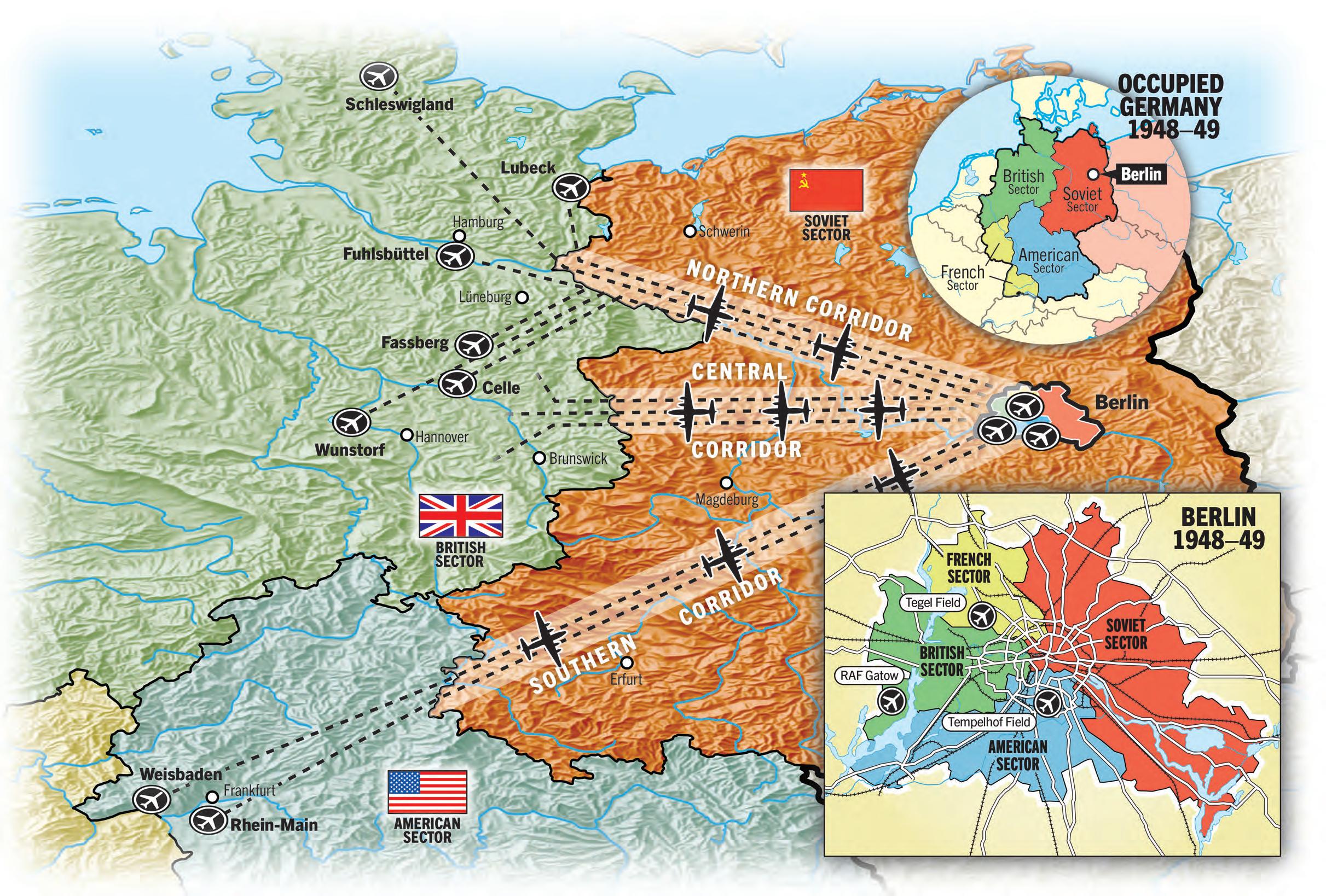

Gail Halvorsen joined the U.S. Army Air Corps in 1942 and trained on fighters with the Royal Air Force. Reassigned to military transport service, Halvorsen remained in the service at war’s end. He was flying Douglas C-74 Globemasters and C-54 Skymasters out of Mobile, Ala., when word came in June 1948 that the Soviet Union had blockaded West Berlin. During the 15-month airlift (Operation Vittles), American and British pilots delivered more than 2.3 million tons of supplies to the city. But it was Halvorsen’s decision to airdrop candy to children (Operation Little Vittles) that clinched an ideological battle and earned him the lasting affection of a free West Berlin. The beloved “Candy Bomber” died at age 101 on Feb. 16, 2022.
In 2009 Military History editor David Lauterborn was fortunate enough to interview Halvorsen. Following is an excerpt of their conversation, available in full online at Historynet.com/candy-bomber-gail-halvorsen.
At the end of the [Tempelhof] runway, in an open space between the bombed-out buildings and barbed wire, kids were watching the airplanes coming in over the rooftops. They came right up to the barbed wire and spoke to me in English: “Don’t give up on us. If we lose our freedom, we’ll never get it back.” American-style freedom was their dream. Hitler’s past and Stalin’s future was their nightmare. I just flipped. Got so interested, I forgot what time it was.
I looked at my watch and said, “Holy cow, I gotta go! Goodbye. Don’t worry.” I took three steps. Then I realized—these kids had me stopped dead in my tracks for over an hour, and not one of 30 had when this for.
put out their hand. They were so grateful for flour, to be free, that they wouldn’t be beggars for something extravagant. This was stronger than overt gratitude—this was silent gratitude. How can I reward these kids?
I went back to the fence and pulled out my two sticks of Wrigley’s Doublemint, broke them in half and passed the four pieces through the barbed wire....I told them, “Come back here tomorrow, and when I come in to land, I’ll drop enough gum for all of you.”
One asked, “How do we know what airplane you’re in?”
“I’ll wiggle the wings.”
“Vas ist viggle?” he asked.
How did you work it?
My copilot and engineer gave me their candy rations—big double handfuls of Hershey, Mounds and Baby Ruth bars and Wrigley’s gum. It was heavy, and I thought, Boy, put that in a bundle and hit ’em in the head going 110 miles an hour, it’ll make the wrong impression. So, I made three handkerchief parachutes and tied strings tight around the candy.
The next day I came in over the field, and there were those kids in that open space. I wiggled the wings, and they just blew up—I can still see their arms. The crew chief threw the rolled-up parachutes out the flare chute behind the pilot seat.
As your efforts grew in scope, did anyone notice?
[One day] an officer met the airplane and said, “The colonel wants to see you right now.” So I went in, and he says, “Whatcha doing, Halvorsen?”
“Flying like mad, sir.”
“I’m not stupid. What else you been doing?” And he pulled out a newspaper with a big article and a photograph of my plane and the tail number. So I told him. He understood, and airlift commander General William Tunner said, “Keep doing it!”
What kept you going?
Without hope the soul dies. And that was so appropriate for the day. In our own neighborhoods people have lost hope, lost function because they have no outside source of inspiration. The airlift was a symbol that we were going to be there—service before self.
Operation Little Vittles dropped more than 21 tons of candy during the airlift. How does that total strike you?
All from two sticks of gum in 1948—unbelievable!
the truck, ready to load the plane for its return trip to Berlin. In Berlin aircrews were told to stay by their aircraft during loading/unloading, instead of going inside for coffee. Mobile canteens, manned by pretty Fräuleins , carried refreshments out to the flight line. After pilots informed Tunner their planes flew sluggishly when carrying coal, CALTF personnel weighed the coal bags. They found that overzealous German workers were packing as much coal in the bags as they could—more than the bags were supposed to hold—resulting in overloaded planes.
The French weren’t part of the CALTF operation. They had few cargo aircraft, and Allied planners were concerned French-speaking pilots might have problems communicating with British and American air traffic controllers. The French did contribute one memorable episode to the airlift story, though. To improve the flow of cargo into Berlin, the Western Allies in November 1948 opened a third airfield, Tegel, in the French occupation zone. Partially obstructing its runway was a broadcast tower used by Soviet-controlled Berliner Rundfunk (Radio Berlin). The French formally
asked the Soviets to move the tower, at Allied expense, but were refused. Then one morning that December General Jean Ganeval, the French commandant in Berlin, summoned to his office American personnel working on the airfield. Some minutes into the meeting they heard an explosion outdoors. The Americans rushed to the window of Ganeval’s office in time to watch the tower collapse to the ground. According to several accounts, Ganeval turned to the shocked Americans and said simply, “You will have no more trouble with the tower.” When the angry Soviets asked Ganeval how he could have done something like that, the French commandant reportedly replied, “With dynamite.”
The Berlin Blockade ultimately backfired on the Soviets. It increased support in the American, British and French occupation zones for the planned West German government. “American intelligence analysts reported widespread demoralization and membership loss among Communists in all parts of [Germany],” note Army historians Donald A. Carter and William Stivers. “The Soviet coercive mea-

sures against Berlin strengthened the Western position in Germany as a whole.” Alarmed Western European nations became more interested in collective security initiatives, an interest that led to the establishment of the North Atlantic Treaty Organization in April 1949.
The airlift, by contrast, proved a public relations bonanza for the Western Allies. In April 1949, on Easter Sunday, the airlift staged a one-day transport blitz during which 1,398 flights carried in 12,941 tons of cargo—the same amount West Berlin had received daily by rail, road and water during peacetime. “I hope that the Communists, who have spent so much time insulting us, will realize that we really aren’t such a soft democracy,” crowed Brig. Gen. Frank L. Howley, the U.S. commandant in Berlin, after the blockade ended. The airlift also improved German-American relations. American newsreels praised West Berliners for their determination to endure the blockade. German children played “airlift” with toy planes. Halvorsen gained headline acclaim as the “Candy Bomber,” dropping candy from handkerchief parachutes to crowds of grateful West Berlin children.

Clay retaliated against the Soviets with his own blockade of raw materials and finished goods that eastern Germany desperately needed from western Germany. For instance, Germany’s best source for coking coal, critical in steel production, were the mines of the Ruhr, in the British occupation zone. Meanwhile, the economy of the Soviet occupation zone, still struggling after World War II, was losing many of its own resources and products to the Russians for their own use. “The eastern zone economy suffered grievously from the counterblockade,” Carter and Stivers wrote. By February Soviet Premier Joseph Stalin, succumbing to a public relations nightmare of his own doing, had signaled American diplomats he was keen to end the crisis.
Yale historian John Lewis Gaddis called the Berlin Airlift “the first clear Soviet defeat in the Cold War.” In hot wars nations inflict defeat on one another using soldiers, armor, airpower and high explosives. The Cold War was a different kind of war, so it’s fitting that its first major victory was won not through violence, but by persistence and excellence in effort. “I don’t have much of a natural sense of rhythm,” Tunner wrote in his memoir. “I’m certainly no threat to Fred Astaire, and a drumstick to me is something that grows on a chicken. But when it comes to airlifts, I want rhythm.” The Americans and British achieved rhythm in the skies over Berlin. They created an airborne conveyor belt that kept a city alive, helped transform the Germans and Americans from wartime enemies into peacetime friends, united Western Europe and inspired freedom-loving people across the globe. MH
Don Smith is a retired U.S. Army Reserve officer with degrees in history and intelligence studies. He’s worked as a defense contractor with various Defense Department agencies for more than 30 years. For further reading he recommends To Save a City, by Roger Miller; Checkmate in Berlin, by Giles Milton; and The City Becomes a Symbol, by William Stivers and Donald A. Carter.
Hard is not impossible. During the 461-day airlift Allied planes carried more than 2.3 million tons of supplies into West Berlin, all told flying almost the distance from Earth to the Sun. Logistics are crucial. Without Maj. Gen. William H. Tunner’s wartime expertise in airlift operations, all might have been lost. Win the PR campaign. The U.S. Air Force announced daily tonnage totals and otherwise won over hearts and minds.
As Russia tottered on the brink of collapse in 1917, Germany resolved to knock it out of World War I with an innovative attack that still informs tactics today
 By David T. Zabecki
By David T. Zabecki
General of the Infantry Oskar von Hutier masterminded the German offensive at Riga, which centered on the synchronicity between infantry infiltration tactics and neutralizing artillery, particularly the use of gas rounds.

The distinctive design of the German Stahlhelm, first fielded at Verdun in 1916, was prompted by an increase in head wounds from bullets and shell fragments.

On the strategic level the Battle of Riga, fought in Latvia on Sept. 1–5, 1917, effectively knocked Russia out of World War I. On the tactical level, however, Riga was even more significant. It marked one of the turning points in the history of warfare. The innovative offensive tactics tested by the Germans in that battle proved the key to breaking the long stalemate of trench warfare. After Riga no attack—or at least no successful attack—would ever again be conducted without some variation on those tactics.
It was a lightning offensive. On Sept. 1, 1917, the German Eighth Army, commanded by General of the Infantry Oskar von Hutier, made an assault crossing of the Dvina River (present-day Daugava) some 15 miles east of the city. The Russian Twelfth Army, commanded by General Dmitri Parsky, collapsed in short order. On September 3 German troops marched into the city, and by September 5 little stood between Hutier’s troops and the Russian capital at Petrograd (present-day St. Petersburg), 300 miles to the northeast.
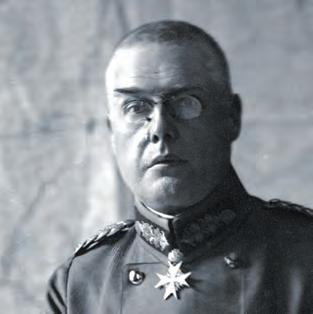
The empire of Tsar Nicholas II had been on the verge of collapse ever since Russia’s humiliating defeat in the 1904–05 Russo-Japanese War, and in March 1917 the provisional government of Georgy Lvov (succeeded in July by Alexander Kerensky) finally did replace the 370-year tsarist regime. Ober Ost, the German military command on the Eastern Front, sensed Russia was ripe for the kill. Ober Ost was then under the nominal command of Field Marshal Prince Leopold of Bavaria; but the real command was exercised by his chief of staff, the brilliant Maj. Gen. Max Hoffmann, the General Staff officer who had been the brains behind the German victory at Tannenberg in 1914. Hoffmann resolved to accelerate Russia’s collapse by striking at the old Hanseatic League port of Riga, on a namesake gulf of the Baltic Sea. Hoffmann’s first move was to order his resident artillery expert, Lt. Col. Georg Bruchmüller, to conduct the preliminary reconnaissance and start fire-support planning for the crossing of the Dvina. In his memoirs Hoffmann deemed Bruchmüller an “artillery genius.” That may have been an understatement. By war’s end Bruchmüller proved central to the development of almost every tactical concept of modern fire support still practiced today.
Bruchmüller’s greatest innovation was the shift from artillery destruction fire to neutralization fire. Rather than trying to destroy everything in the path of the attacking infantry, Bruchmüller focused on tightly synchronizing the fire support and the infantry scheme of maneuver to neutralize the enemy defense just long enough for the


attacking infantry to overrun it. He was especially innovative in the way he used combinations of persistent and nonpersistent gas to neutralize selected targets. Thus, while the typical artillery preparation in 1917 lasted a week or even two weeks, Bruchmüller’s preparations lasted only a matter of hours, with far better effect.
The Eighth Army’s infantry, meanwhile, was trained in an experimental attack doctrine the Germans would officially adopt in January 1918, itself a large-scale application of small-unit tactics that had been under development since late 1915. Captain Willy Rohr, the commander of Germany’s first unit of storm troops, was among its proponents and pioneers. Rather than advancing in the rigid, linear attack formations so characteristic of World War I, Hutier’s infantry was trained to advance using fluid infiltration tactics. The infantry companies were organized into small, highly trained combined-arms assault elements. Advancing leapfrog fashion, the small assault teams probed for weak spots and bypassed enemy strongpoints, leaving them for heavier follow-on forces to reduce. Reserves were committed to reinforce success rather than being thrown in where the attack had stalled. The assault teams pushed deep into the defender’s position, threatening his artillery and disrupting his communications systems. Rather than blind conformance with an established plan, the attackers down to the lowestlevel leaders and even the individual soldiers were trained to use imagination and initiative to accomplish their missions. By the standards of World War I, these were radical innovations. At Riga the German army would conduct the first large-scale test of these “infiltration tactics,” often referred to incorrectly as “Hutier tactics” or “storm troop tactics.” Riga was also the first clash in which the new infantry assault tactics and Bruchmüller’s artillery tactics were combined and synchronized.
Defending the Riga sector were the Russian Twelfth Army’s 15 infantry divisions and single cavalry division, a force numbering some 192,000 troops. Russian defenses north of the Dvina were organized in two parallel positions. The first position comprised three, and in some places four, successive trench lines dug into the dunes along the river. The second position consisted of two sets of trench lines anchored along a smaller river the Germans called the Kleine Jägel (the present-day Maza Jugla), a few miles northeast of the Dvina. (The five-day clash is sometimes referred to as the Battle of Jugla.)
Facing the Russians opposite Riga, deployed along the south bank of the river, Hutier initially fielded just over seven divisions along an 80-mile front running from the coast southeast to Jakobstadt (present-day Jekabpils). Ober Ost reinforced the Eighth Army with an additional eight infantry and two cavalry divisions. That gave Hutier sufficient strength to make his main effort, conduct holding attacks against the front of the city and secure the rest of his line along the Dvina. Hutier planned to make his main effort a crossing of the Dvina near Üxküll (present-day Ikskile), some 15 miles downriver from the city. He committed 10 divisions of about 60,000 troops to the crossing. Once across the Germans could maneuver around to the rear of the city and cut off the Russian garrison.
Hutier prepared for the offensive by assembling his attack divisions some 80 miles behind his front lines, where they trained and rehearsed for 10 days. The attacking divisions


did not move up into their jump-off positions until the night before the attack. At 0910 hours on September 1 three divisions of Hutier’s LI Corps spearheaded the attack on a 10,000-yard front. The 19th Reserve Division, on the right, and the 2nd Guards Division, on the left, forced a crossing of the Dvina with assault boats and pontoon bridges. The 14th Bavarian Division in the center had to take heavily fortified Borkum Island as an intermediate objective. Once across the river the three divisions quickly overran the Russians’ first defensive positions and moved on toward the second. While the lead German elements were advancing on the second position, German pioneers started building fixed bridges across the river in each of the three divisional attack sectors. Once the bridges were up a second division crossed behind each first echelon division and prepared to exploit the breakout from the Russians’ second defensive positions.
In addition to the extra infantry divisions, Ober Ost had given the Eighth Army massive artillery reinforcements by

On
stripping the Eastern Front of everything but the minimum number of guns necessary to hold the line in the other sectors. Some guns were even transferred in from the Western Front. With painstaking secrecy Bruchmüller supervised the movement of 615 guns (including 251 heavy guns) and 544 trench mortars into the 5-mile-wide penetration
at selected targets to achieve precise results. Throughout the entire length of the fire the German guns and mortars fired an average of 500 gas rounds per minute on key targets in the penetration zone.

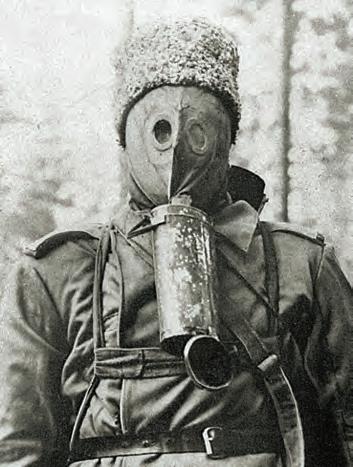
Bruchmüller’s preparatory barrage lasted five hours and 10 minutes. Though short by World War I standards, it was incredibly violent. At 0400 hours all 615 German guns opened up against the Russian artillery positions, firing 75 percent gas to 25 percent high explosive. After two hours of this reinforced counterbattery fire those German firing units with a specific counterbattery mission continued to pound the Russian artillery, while the rest of the German guns shifted to Russian infantry targets and started firing 20 percent gas to 80 percent high explosive. At that point the short-range trench mortars joined in, concentrating their fire on the Russian frontline positions. The fire against infantry targets lasted three hours and 10 minutes and was divided into four phases. At 0850 hours, 30 minutes into the last phase, the counterbattery guns also shifted to the Russian infantry positions, leaving only one gun per battery to continue stoking the gas clouds enveloping the Russian guns. This final 20 minutes of the preparation was a saturation of the Russian front lines, with all guns and trench mortars firing at their maximum rates of fire. Although gas had been used on the World War I battlefields as early as January 1915, it had never been used with such precision and exacting effect. As British strategist Maj. Gen. J.F.C. Fuller later wrote in The Conduct of War, 1789-1961, “The first skillful use of gas to effect a penetration was made in General von Hutier’s attack on the Riga front.”
At 0910 hours the German infantry surged across the river. Forward observers accompanying the assault elements crossed with the first wave after tying down their phone lines to prepositioned stakes at the ferry points.

Georg Bruchmüller was primarily responsible for introducing to the German army centralized fire planning above the divisional level. Despite resistance from hard-line traditionalists, Bruchmüller paid little attention to whether a given unit was field artillery or foot (heavy) artillery. He assembled task-tailored groups to accomplish specific tactical missions based on the capabilities of the guns.
The Counter–Infantry Groups, Infantriebekämpfungs-Artillerie (IKA), accounted for some 75 percent of the available guns. The IKA mission was direct support for the attacking infantry. One IKA group was assigned to each first echelon attacking division, and one subgroup to each of its frontline regiments. The Counter-Artillery Groups, Artilleriebekämpfungs-Artillerie (AKA), accounted for 20 percent of the guns. The AKA, whose primary mission was counterbattery fire, was organized into one group per corps in the main attack sector and one subgroup per division. The standard practice during World War I had been to use heavy guns and howitzers for counterbattery work. Bruchmüller, however, used a large proportion of light field guns, which had higher rates of fire and could blanket their targets with chemical rounds.
The heaviest German field guns (but not the howitzers) were assigned to the Heaviest Flat-Trajectory Artillery, Schwerste Flachfeuer-Artillerie (SCHWEFLA). Its guns undertook pinpoint destruction missions against selected enemy command and control nodes and other key targets, such as bridges and rail junctions. Normally one SCHWEFLA group was assigned to each field army. The mission of the Deep Battle Artillery, FernkämpfArtillerie (FEKA), was long-range fire against key flank targets and rear lines of communications. Normally, one FEKA group was assigned to each corps in the main attack sector. Bruchmüller’s FEKA groups were among the first units on the battlefield with a specific deep battle mission. The concept of deep battle operations conducted far beyond the immediate line of contact has become a defining feature of modern combat. —D.T.Z.

Once they were across, the assault from the north bank was preceded by a carefully orchestrated creeping barrage. With the exception of the one gun per battery still firing on the Russian gun positions, the German counterbattery guns continued to fire on deeper infantry targets during the first two phases of the creeping barrage.
As soon as the first wave of German infantry had firmly established itself on the north shore, the counterbattery guns turned their attention back to the Russian batteries. About that time the Germans put a number of light field guns across the river on rafts. In the days prior to the attack
Bruchmüller’s gunners had rehearsed this technique on the lakes in the Eighth Army’s rear area. Meanwhile, specially trained detachments of gunners from the heavy artillery units crossed the river to take over any abandoned Russian guns in the forward positions. The bulk of the heavier German guns remained throughout the first day on the south bank of the river, having sufficient range to engage the Russian second positions.
Once the Russians’ second defensive positions were overrun, the Germans executed three successive programs of planned defensive fires. The first program provided cover
Don’t get entrenched. Three years into a war characterized by static trench warfare Hutier introduced combinedarms tactics still in use by modern-day armies. Synchronize forces. The German success at Riga depended on the split-second synchronization of creeping artillery barrages and infantry infiltration tactics. Rate of fire is key. During Bruchmüller’s preparatory barrage, which lasted five hours, his artillery crews sent more than 560,000 rounds downrange.
from the time the Russian second defensive position fell until the completion of the fixed bridges over the Dvina. Once those bridges were completed, the Germans moved more artillery across. The second program of defensive fires ran from the completion of the bridges until the artillery that moved across got into position and registered. Once that was accomplished, those guns took over the third set of defensive fires that lasted until everything was ready for the start of the exploitation phase from the Russian second position.
The effects of the German fire were devastating. During the slightly more than five hours of the preparation alone the German gunners hit the Twelfth Army with more than 560,000 rounds—an average of 480 rounds per tube. Any artillery crewman who has ever manhandled ammunition will testify to the backbreaking nature of such a sustained rate of fire. Some 27 percent of the total rounds fired were gas, the highest proportion of such rounds fired in any battle of the war to that time. The total weight of the high explosive shells fired came to approximately 10,500 tons—the equivalent of the armament payload of 300 present-day Boeing B-52H Stratofortress bombers.

Three hours after the first assault wave crossed the river, the Russians started to break. Late that afternoon Twelfth
Army commander Parsky ordered his XLIII Corps to counterattack with four divisions and the Latvian 2nd Rifle Brigade. By nightfall, however, the Germans had six divisions across the Dvina, with a bridgehead 8 miles wide. Early on September 2 the Russian counterattack force took up positions along the Little Jägel. The Germans responded with a heavy artillery barrage followed by an attack supported by flamethrowers and ground attack aircraft. The Russians and Latvians managed to hold out for about 24 hours, while the remainder of the Twelfth Army started evacuating Riga.
60,000 GERMAN SOLDIERS
4,200
CASUALTIES
192,000 RUSSIAN SOLDIERS INCLUDING 18,500 LATVIAN RIFLEMEN
25,000 CASUALTIES
15,000 CAPTURED AND MISSING
After the Germans fought their way across the Little Jägel, one part of the attack force broke off to the west and advanced on Riga itself. They entered the city with relatively little opposition in the afternoon of September 3. Simultaneously a German naval force broke through a Russian minefield at the mouth of the Dvina and approached the city from the river. The remainder of Hutier’s force kept pressing northeast, reaching the Grosse Jägel (the present-day Liela Jugla) by day’s end. Neither arm of the German advance, however, managed to prevent the bulk of the Twelfth Army from escaping.
The German attack ended on September 5. The operation had cost the Germans 4,200 casualties to Russia’s 25,000. The Russians also lost some 180 guns and 200 machine guns. After Riga fell, Russia also lost whatever stomach it had for staying in the war. The Bolshevik revolution overthrew Russia’s provisional government on November 7 (October 25 on the traditional Russian calendar). Four days earlier Leon Trotsky had issued a series of demands in the name of the Petrograd Soviet, which included “immediate armistice on all fronts.”
With Trotsky and Vladimir Lenin in Petrograd, and things destabilizing very nicely, Germany had no real incentive to continue large-scale military operations against Russia. It had bigger fish to fry. Thus, most of Ober Ost’s effective combat forces were transferred to the Western Front, where General Erich Ludendorff was planning his grand 1918 spring offensive, which he was convinced could still win the war for Germany.
The transfers to the Western Front included Hutier and Bruchmüller and their staffs. Hutier assumed command of the newly established Eighteenth Army, one of three armies that launched the massive Operation Michael on March 21, 1918. All the German forces in that operation employed the tactics that had proved so successful at Riga, and Bruchmüller planned and oversaw the greatest artillery barrage in the history of warfare to that point. Hutier was awarded the Mérite for his capture of Riga. Bruchmüller had already received the decoration for previous service on the Eastern Front. Both would re ceive the higher-level Pour le Mérite leaves for their roles in Operation Michael. (The Pour le Mérite with oak leaves was awarded only 122 times during World War I.)

Like the Battle of Riga, Operation Michael was an overwhelming tactical success, but unlike Riga, Michael was a strategic failure. All the battlefield virtuosity the Germans could muster was not enough to overcome the deci sive strategic advantages of the Western Allies. The Germans were simply out of manpower. The Americans had just entered the war, and by March 1918 they were pouring more than 100,000 troops per month into Europe. The French and British, however, did receive a bloody nose in March 1918, as the Germans took more ground in less time than almost all of the previous Western Front battles combined. The Germans followed up with similar massive offensives in April, May and July. But though they kept taking ground and inflicting high casualties, it was not enough to tip the balance in the bloody calculus of World War I.

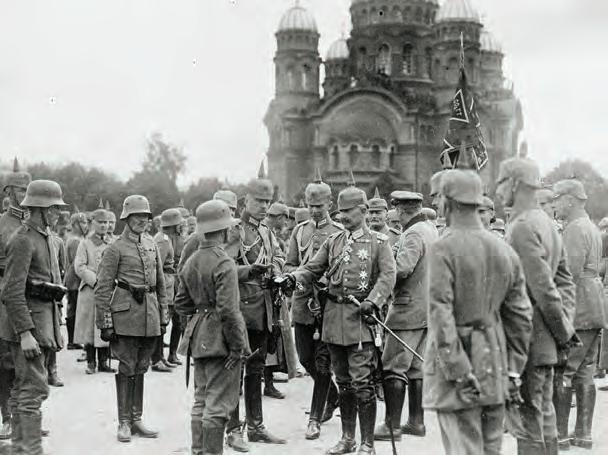
The Allies, meanwhile, learned their lesson quickly. By July 1918 they too were using the same sort of flexible combined-arms tactics the Germans had pioneered at Riga. The stalemate of trench warfare was finally broken. The Russians learned the lessons of Riga as well, but too late to do them any good in World War I. Between the world wars, however, Soviet military theorists scrutinized German military operations during World War I and developed their own tactical techniques and procedures based on the same fundamental principles. They paid special attention to Bruchmüller, who in the 1920s wrote two books about his experiences, which included detailed information about the fire planning for Riga. Lieutenant General Yuri Sheydeman, chief of the Red Army’s artillery from 1921 to ’37, personally translated one of Bruchmüller’s books from German into Russian. Most of Bruchmüller’s fire-support principles and techniques were echoed in the 1937 edition of Artillery Training Regulations of the Red Army, the basic manual of Soviet artillery doctrine for World War II. Between 1941 and ’45 the Soviets on a hundred battlefields paid back the Germans for Riga in their own coin. MH
Retired U.S. Army Maj. Gen. David T. Zabecki is Historynet’s chief military historian. For further reading he recommends his own Steel Wind: Colonel Georg Bruchmüller and the Birth of Modern Artillery, as well as Russia’s Last Gasp: The Eastern Front 1916–17, by Prit Buttar.
The earliest depictions of war served one purpose: to emphasize the invincible might of the leaders who commissioned them. A stroke of accuracy might be useful toward establishing credibility, but only so long as it served the warlord’s purposes. Pharaoh Ramses II, for example, employed what amounted to a private propaganda bureau to back up his claims to godhood. Witness Egyptian depictions of his 1274 bc victory at Kadesh. His Hittite opponents commemorated it as their victory, though in reality it ended in an inconclusive standoff. Over the subsequent millennia war artists have wrestled with the matter of balancing accuracy and the lionization of their subject, who was very often the supporting patron. However effective a depiction of battle may be in its own time, posterity often brings out the nitpickers. Often even the most well-meaning attempts at accuracy miss something. Just as often errors, accidental or deliberate, can be glaring. In any case, the advocates of historicity have their own leg to stand on in their conviction that a true act of valor can and should stand on its own merits. MH
A One of French First Consul Napoléon Bonaparte’s military coups was his spring 1800 crossing of the Alps to surprise the Austrians in Italy. In 1850 Paul Delaroche, aided by Adolphe Thiers’ 1845 account of the crossing, depicted a sensible, if not terribly heroic, Napoléon picking his way through Great St. Bernard Pass on a sure-footed mule appropriated from a convent at Martigny and led by a local guide. Contemporaries critiqued Delaroche’s realistic approach for having failed to capture its subject’s spirit. Ironically, he ended up selling a smaller copy of the painting to Queen Victoria of Britain, who presented it to husband Prince Albert on his birthday, Aug. 26, 1853. B Between 1801 and ’05 one of the future emperor’s most devoted admirers and propagandists, Jacques-Louis David, painted five versions of the crossing, all showing Napoléon atop a rearing charger behind an outcrop carved with his name and those of his illustrious martial predecessors Hannibal and Charlemagne.
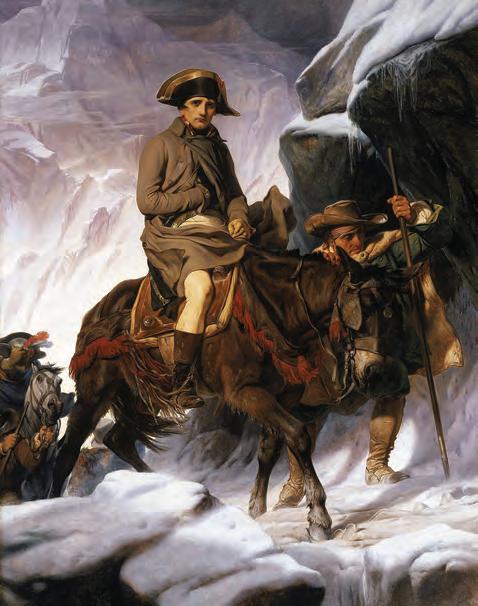
Some painters meticulously researched their masterworks—others not so much



EFGC German muralist Wilhelm von Kaulbach’s epic 1868 canvas The Naval Battle of Salamis reflects a recurring problem whenever artists weigh accuracy against epic—namely, fitting everyone into the available space. Painted for display in Munich’s palatial Maximilianeum, his depiction of the 480 bc clash squeezes in Themistocles, Xerxes, Artemisia of Caria and even a few Greek gods. D Similarly, in his 1849 painting The Conquest of the Teocalli Temple by Cortés and His Troops (Aztec Temple in Tenochtitlan, 1520) German-American painter Emanuel Leutze had many points to make, historicity being beside the point. E In his 1770 work The Death of Wolfe Benjamin West depicts mortally wounded British Maj. Gen. James Wolfe achieving martyrdom as he learns of his victory at Quebec. Joining Wolfe’s nattily dressed officers is a contemplative British-allied Indian, though none were present.

F Rendered in 1851, Leutze’s iconic Washington Crossing the Delaware, with its all-inclusive crew of Continentals and Patriot volunteers setting out to attack the Hessians at Trenton, N.J., on the morning of Dec. 26, 1775, transcended several egregious errors. For example, there was no Stars and Stripes flag until June 1777; the crossing was made around midnight amid a snowstorm over a narrower stretch of river; and General George Washington’s men crossed in larger, flat-bottomed Durham boats. G Painted for the U.S. Navy in 1962, Vladimir Zveg’s Battle of the Virginia Capes, 5 September 1781 is forced by space constraints to close the combatant ships to point-blank range. Another gaffe is the Union Jack, whose red Cross of St. Patrick was not added until 1801.


HH Henry Arthur McArdle was obsessed with the March 6, 1836, Battle of the Alamo and tried to have things both ways—capturing the fight down to the most minute detail, but succumbing to the urge to glorify the Texians’ last stand. The artist’s 1905 Dawn at the Alamo depicts Jim Bowie (at left with knife in hand, though he was bedridden at the time) battling Mexican troops alongside David Crockett (in shirtsleeves at right) and William Barret Travis (larger than life atop the battlements). I Few battles have been so widely painted as George Armstrong Custer’s Last Stand at the Little Bighorn (known by American Indian victors as the Greasy Grass), but only in recent years have reasonable renditions emerged. Painted the year of the battle, Feodor Fuchs’ version includes such hokum as a fight on horseback (the soldiers were dismounted), the use of sabers (not taken) and Custer’s fancy dress jacket (vs. buckskin).

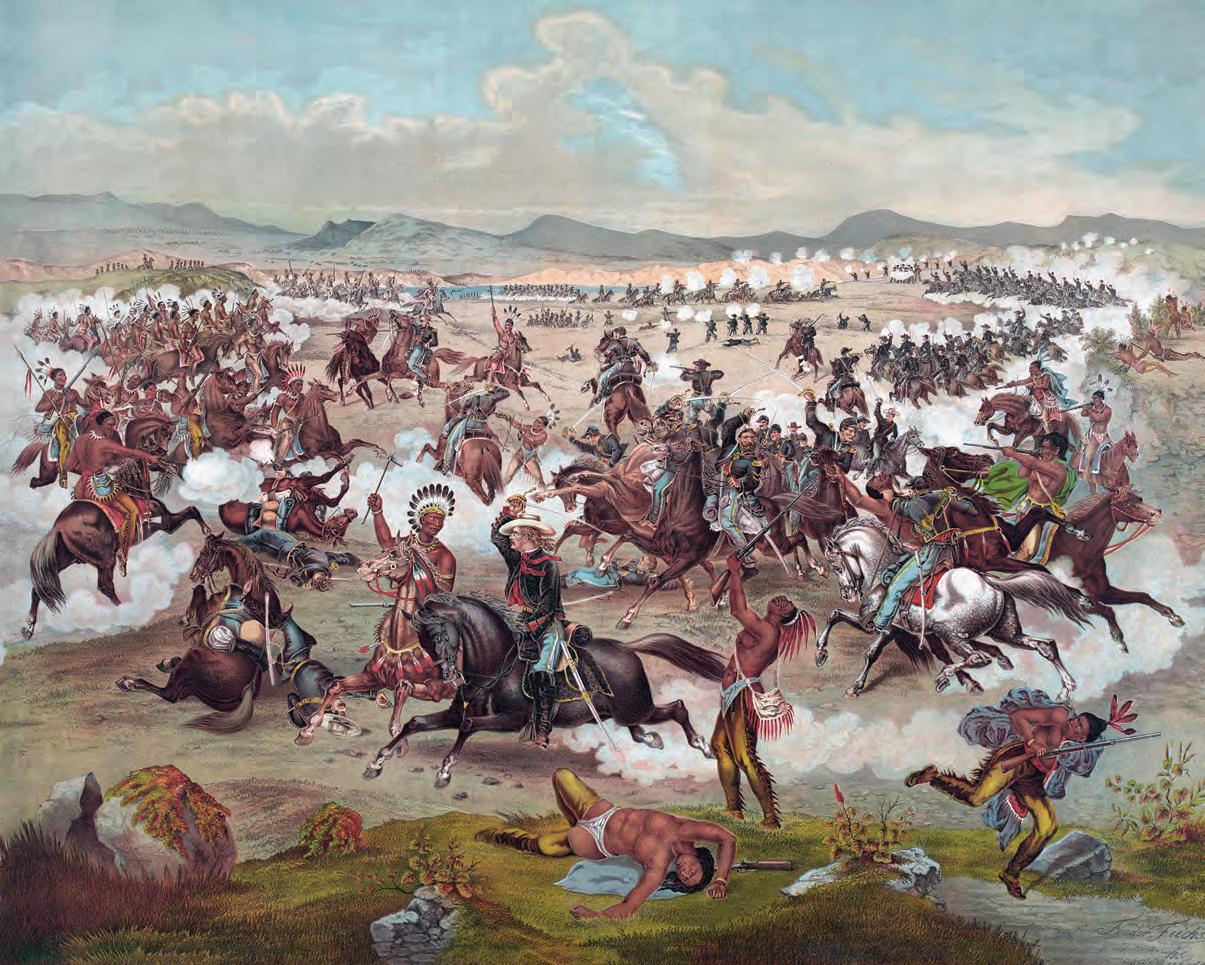
KJ This Ethiopian depiction of the March 1, 1896, Battle of Adwa— the first decisive African victory over a European power in the 19th century—lacks perspective and depicts a set-piece battle, complete with an intervention by Saint George. Missing are such details as the Italian blunder of having split their army in three. Another mistake is the green, yellow and red Ethiopian flag, colors not adopted until 1897.

K In Charles Hubbell’s depiction of the April 21, 1918, death of German fighter ace Manfred von Richthofen the all-red Fokker Dr.I is correct, but by then the flared Maltese cross had been replaced by the straight-armed Balkenkreuz. Of course, Canadian Sopwith Camel pilot Roy Brown never got that close. Regardless, the bullet that killed the Red Baron in fact came from a Vickers gun fired by an Australian foot soldier.

The French and allied Indians achieved total surprise with their 1704 raid on Deerfield, Massachusetts, but its reverberations stoked the ultimate downfall of New France
 By P.G. Smith
By P.G. Smith

Carved
The ragged force of 250 French Canadian, Abenaki, Huron and Mohawk warriors hunkered down in the snowy underbrush just before midnight on Feb. 28, 1704. They wrapped their blanket coats and furs tightly about themselves and kept careful watch for any signs their presence had been detected. The men had arrived at a frozen meadow just north of the village of Deerfield, in the Province of Massachusetts Bay, after an arduous journey of more than 300 miles on snowshoes from Chambly, Quebec. Although they surely smelled the wood fires burning in nearby hearths, the warriors could only huddle together for warmth—campfires would risk the all-important advantage of surprise. They chewed on the last of the dried pemmican and corn to ease the gnawing in their bellies. If everything went according to plan, they would all soon eat their fill from the kitchens of New Englanders.
While some warriors quietly chanted tribal war songs, others, particularly the French Canadians and their Roman Catholic Mohawk and Huron allies, whispered Christian prayers for the success of their raid against the heretic English Protestants. For the French and some warriors the expedition was a religious crusade, encouraged by Roman Catholic priests in New France. For the Mohawks the raid also offered the promise of captives to be adopted into their clans. For some of the Abenakis the attack would serve as vengeance against the English for having been evicted from their lands. All warriors looked forward to the rewards of plunder and the wealth the sale of captives could bring.
In the predawn darkness Lieutenant Jean-Baptiste Hertel de Rouville, the expedition’s French Canadian commander, quickly dispatched scouts to observe the sleeping hamlet. The 35-year-old Hertel was the son of renowned bush fighter Joseph-François Hertel de la Fresnière. The younger Hertel was no stranger to frontier partisan warfare, having accompanied his father on raids against the English settlements of Salmon Falls and Casco, in what today is Maine, and Schenectady, N.Y. But this was his first command.
Philippe de Rigaud, the Marquis de Vaudreuil and governor general of New France, had ordered the raid deep
Crown to approve his family’s petition for nobility, a request previously denied due to his father’s lack of wealth. As he waited in the darkness, however, Hertel must have been singularly focused on ensuring the war chiefs of the various tribes, as well as his French Canadian subordinates, clearly understood the plan of attack.

Ensconced within Deerfield’s stockade walls, the Rev. John Williams lay in bed beside his wife, Eunice. He had likely read Bible passages to his seven children as they gathered around the blazing stone hearth after dinner. Perhaps the Williams’ slaves, Frank and Parthena, and the pair of militiamen quartered in the house had joined them by the fire until it was time for bed.
They and their fellow townspeople slept soundly. True, back in October two settlers working in the fields outside the village had been captured by marauding warriors, stoking fear. But such risk was part of the price Deerfield’s 270 inhabitants were willing to pay for fertile farmland on the western fringes of Massachusetts. Months had passed with no attacks.
into New England. His instructions were in keeping with directives from the court of Louis XIV to conduct offensive actions that would strike terror into the English and deter their territorial expansion in North America. The expedition had the secondary goal of drawing northern tribes into the broader struggle between the European powers by binding them to the French through plunder, captives and bloodshed. On a more personal level, Hertel hoped a successful outcome would finally convince the
Not to say townspeople were complacent. Reasonable precautions could reduce the risk of French and Indian attack, and the Rev. Williams and other prominent leaders had petitioned the Massachusetts Legislature for protection. Indeed, it was in the best interest of Massachusetts, as well as Connecticut, to defend Deerfield and other frontier settlements rather than do battle with raiders in the streets of Boston or Hartford. The Legislature duly dispatched soldiers to Deerfield and approved a tax abatement so the town
Screams resounded in homes where residents had quietly slumbered just moments before
could repair the crumbling wooden stockade that enclosed the heart of the village. Connecticut also sent troops.
Periodic reports about a large force of French and Indians assembling near Montreal had reached Deerfield as early as the summer of 1703, but there had been scant enemy activity, other than the autumn marauders. Subsequent reports generated fresh anxiety, but the rumored threats never materialized, and Massachusetts and Connecticut had ultimately withdrawn their forces. Finally, the leaves turned crimson and gold, temperatures dropped and the snow fell.
By the morning of February 29 a 3-foot-deep blanket of snow lay on the ground, further lulling townspeople into a sense of security. Surely such deep snow would impede the progress of any attacking force, or at least slow them to the point the alarm could be sounded in plenty of time to establish a solid defense. Furthermore, 20 militiamen had arrived just four days ago. So, the townspeople slept on.
Two hours before dawn Lieutenant Hertel listened with eagerness to the hushed reports of his scouts. Snow had drifted up against the 10-foot-high northern wall of the Deerfield stockade. Nimble men on snowshoes should be able to scamper up over the wall and drop down into the
village. Once inside, the advance party could open the gates for the attacking force.
Hertel ordered his men to advance to concealed positions just outside the stockade. Rather than approach en masse, small squads rushed forward for short distances to mimic the sound of wind gusts. Once the entire force was in position, they awaited their opportunity to strike. The only complication was a lone militiaman on night watch, keeping a listless patrol inside the stockade.
The militiamen had undoubtedly taken turns at watch, patrolling the perimeter through the long winter’s night, trudging through the snow and lugging their heavy muskets up and down the watchtower ladders. Like most colonial militiamen, they were probably poor, unskilled young men offered up by neighboring towns to fill the militia levy.
Perhaps they assumed no raiding party of any size could advance quickly and quietly through the deep snow. Perhaps they thought the reinforced palisade would thwart any invaders from entering the village. Perhaps, like the sleeping townspeople, they were wrong.

simultaneously, thus attaining total sur prise, minimizing resistance and limiting one’s own casualties.
But something went wrong. While Hertel’s raiders were still pouring through the north gate, a musket shot rang out, probably fired by the latereacting sentry. Chaos erupted as mixed bands of French, Mohawks, Abenakis and Hurons fanned out through the sleeping village.
The Rev. Williams leaped from his bed at the commotion and hurriedly retrieved and cocked his flintlock pistol. As a clutch of warriors burst into his bedroom, he pointed its muzzle at the leading Abenaki and pulled the trigger. The resulting harmless click of a misfire probably saved the reverend’s life. Had Williams shot the Abenaki, follow-on warriors would almost certainly have slain him on the spot. Things were bad enough.



His assailants overpowered the reverend and bound his hands. Meanwhile, elsewhere in the house warriors murdered
the village lanes and in homes where residents had quietly slumbered just moments before. Lieutenant Hertel must have been exasperated as he watched his plans evaporate into mayhem. All hope of command and control was gone.
Several townspeople, particularly those in the southern end of the village, fled in the direction of the nearby towns of Hatfield and Hadley. Some managed to shelter south of the village in the garrison house of Captain Jonathan Wells. Others burrowed into cellars and likely nooks to evade the attackers. Several of those in hiding survived the raid. Other unfortunates burned alive when their houses were set afire.
The raiders spread death and destruction throughout the village, indiscriminately killing babies and young children who would prove a burden to them on the return march to New France. They set torch to all structures in the village and slaughtered as many cows and sheep as they could while plundering food stocks and portable items of any value.
Entire families were rounded up and herded into the meetinghouse, which served as a holding area for captives. The raiders captured 112 residents of Deerfield and killed 50 others during the attack. But not all villagers were slain or taken without a fight.

Sergeant Benoni Stebbins had escaped from Indian captivity as a young man and resolved never to be captured again. Built for defense, the inner and outer walls of his house were filled with “nogging”—unfired bricks certain to stop musket balls. At the first sounds of the attack Stebbins had rushed to secure his home, which sheltered seven men, five women and several children. The well-armed defenders were determined to hold out as long as possible.
Hertel sent wave after wave of attackers in a costly effort to either overwhelm Stebbins’ outpost or set it afire. It would have proved smarter to bypass it. A Huron chief, an Abenaki captain and Ensign François-Marie Margane de Batilly were among the raiders killed or mortally wounded during the assaults. Hertel himself was wounded while leading one of the attacks, though the wound didn’t appear serious. At one point the French offered the defenders terms of surrender, but Stebbins would have none of it. After a firefight of more than two and a half hours, the raiders finally broke off the attack, but only after they’d wounded one of the women and a militiaman and killed the valiant Sergeant Stebbins.
As the first rays of dawn shone through the thick smoke, small groups of attackers made their way back toward the meadow where they had gathered the night before. Their progress was slowed by the plunder they carried and the bound prisoners who stumbled through the snow, choking
on acrid smoke and their bitter tears. Behind them lay the blood trails of slain villagers and butchered farm animals, as well as the smoldering remains of their homes and everything they owned.
Lieutenant Hertel, anticipating counterattackers would not be far behind, sternly ordered his men to hurry. The chastened raiders in turn brandished hatchets and threatened their weeping captives to pick up their pace or face a quick death. Not all raiders heeded their commander’s warnings, however. Some lagged behind in the greedy search for further plunder or drunken bloodlust as they searched the ruins for more victims.
By early morning a force of armed New Englanders, alerted to the attack on Deerfield, rode to its relief from villages to the south. The force gained strength along the way, adding to their number soldiers who had taken refuge in Captain Wells’ fortified home. Other militiamen who’d fled the attack joined the group of 30-odd avenging New Englanders as they approached the charred village and engaged in a chaotic running fight with the last of the straggling raiders. Faced with the fury of the enraged militiamen,

Complacency kills. Provincial officials had earlier garrisoned the village, but months had passed with no attack, and only one drowsy sentry stood guard the night of the raid. Stealth is paramount. The 250-man party of French and allied Indian warriors plodded more than 300 miles in snowshoes to strike in the predawn darkness. Don’t give up hope. More than 100 Deerfield residents successfully held out. Rallying them were Jonathan Wells, Benoni Stebbins and other trained soldiers.
Hertel knew from experience the New Englanders would follow. He also realized that his force, strung out and burdened by captives and plunder, would never be able to outrun pursuers hellbent on vengeance. But the experienced officer also understood that emotionally charged counterattackers were likely to act in haste, without proper reconnaissance. So, he rallied 30 reliable men and concealed them along a riverbank with clear fields of fire.
The New England relief force, having chased the last of the raiders out of the village, soon gained a true understanding of the wanton carnage resulting from the attack. Giving vent to anger and rage, some militiamen threw aside their coats and cumbersome equipment and ran in pursuit of the French and their allied warriors. Cooler heads, like Captain Wells, tried to establish command and control, but to no avail.
As the infuriated New Englanders ran headlong toward the river, Hertel sprang his trap. The concealed raiders opened fire, killing nine counterattackers and wounding many more. Though the raiders also suffered casualties, they succeeded in driving the New Englanders back behind the Deerfield stockade.
The march into captivity was a bitter ordeal. Of the 112 residents captured at Deerfield, only 89 survived the trek to New France. Warriors killed any unable to keep pace.
By nightfall the next day nearly 250 soldiers and armed citizens from western Massachusetts and Connecticut had gathered amid the smoking rubble of Deerfield. Though many were anxious to begin the pursuit of the French and Indian raiders, their leaders convened a war council. As they weighed the merits of various courses of action, the weather warmed and rain began to fall. Those with prior military experience realized the deep slush would slow progress to a crawl. Their plodding approach would in turn alert the raiders, who would probably massacre their captives. In the end, wiser voices prevailed, and the counterattack was called off.
The New Englanders returned to their homes harboring grief and hatred while the raiders and their captives slogged north through the snow.
The long and torturous journey to New France was marked by atrocities, including the drunken murder of Frank, the Williams’ slave, and the heartless killing of Eunice Williams, who was unable to keep pace because she’d recently given birth. A few Englishmen escaped, but warriors killed all those who fell behind. Of the original 112 captives, 89 survived the trek. Firsthand accounts also record small acts of humanity, like the strong words and actions of Huron warrior Thaovenhosen as he implored fellow tribesmen to spare captives from torture and mutilation.

On his triumphant return Lieutenant Hertel received widespread praise for the success of the Deerfield raid. While he led other raids and held additional commands, nothing compared to the devastating impact of the 1704 attack. Hertel was eventually promoted to captain, founded and served as commandant of Fort Dauphin (present-day Englishtown, Nova Scotia) and was decorated with the prestigious Ordre de Saint-Louis. The Hertel family finally received its patent of nobility in 1716.
The fate of the surviving Deerfield captives varied considerably once they reached Montreal and environs. Two men were worked and starved to death by their Abenaki captors. Most townspeople, however, were ransomed by French Canadian citizens, who treated them with compassion and humanity. Though not compelled by force to remain in New France, those who did stay were strongly encouraged to embrace Roman Catholicism. Some captives were adopted as full members of warriors’ tribes. Of the captives who survived the trek, some 60 eventually returned to New England. Many others married and began families, choosing to remain in New France the rest of their lives.
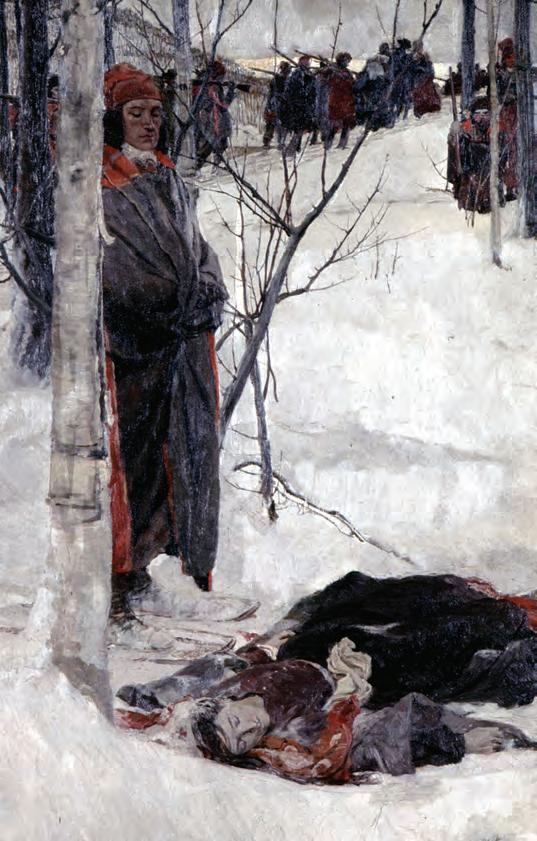
The Rev. Williams and four of his children were among those who returned home, in 1706. By then his 10-year-old daughter, Eunice, had been adopted by the Mohawks. She later married a Mohawk and bore their children in New France. Though she visited her New England relatives on several occasions, she and her growing family made their home in Kahnawake, a Mohawk community on the St. Lawrence River opposite Montreal.

Such happy endings aside, the Deerfield raid had been an act of terrorism, intended to strike fear into a target population through brutal violence, indiscriminate destruction and random victimization of noncombatants. Like many such terrorist acts, the raid was successful in the short term, as the fear of further French and Indian attacks discouraged English settlement in northern New England, if only temporarily. The raid also prompted overreaction against New England tribes as the English launched their own savage, punitive raids.
In the end, however, the policy of terrorism initiated by the French Crown only served to inflame England and her colonists and prompt acts of retribution, like the sorrowful expulsion of French Canadians from Acadia a half century later. Ultimately, the bitter harvest reaped at Deerfield contributed to the final defeat of New France in the 1754–63 French and Indian War. MH
Retired Brig. Gen. P.G. Smith, a former commander of the Massachusetts Army National Guard, teaches counterterrorism strategy at Nichols College in Dudley, Mass. For further reading he recommends Captors and Captives: The 1704 French and Indian Raid on Deerfield and Captive Histories: English, French and Native Narratives of the 1704 Deerfield Raid, both by Evan Haefeli and Kevin Sweeney, as well as The Unredeemed Captive: A Family Story from Early America, by John Demos.

In 1995 Peru and Ecuador waged a 34-day border dispute with Spanish colonial origins using the latest in jet aircraft, GPS technology and ground-based weapons
By Jerome LongBy the outset of the 1995 war Ecuador had modernized its military and quickly achieved air superiority with such jets as this French-built Dassault Mirage F1JA.

There it was again. He was sure of it now. Muffled by the dense Amazonian undergrowth came the low rumbling of a vehicle moving at barely a crawl. Ecuadorian Corporal 1st Class José Maria Marasco froze stock-still in his outpost as he tried to determine the vehicle’s direction of movement. It seemed closer now, and he could hear the snapping of branches beneath the vehicle’s tires. Then he heard their muted voices—the hated Peruvians. An officer giving orders. A sergeant giving directions. And they were all coming toward him. The war he knew was coming had arrived in the Cenepa Valley. Marasco whispered what he heard and saw into the mouthpiece of his landline and then silently made his way back to his unit.
Ecuadorian and Peruvian units had patrolled the disputed valley for years without incident, despite their mutual hatred. Sometimes their officers even got together for talks. Then, in 1995, Peruvian forces invaded the disputed area, seeking to evict the Ecuadorian troops dug in on the high ground overlooking the river basin.
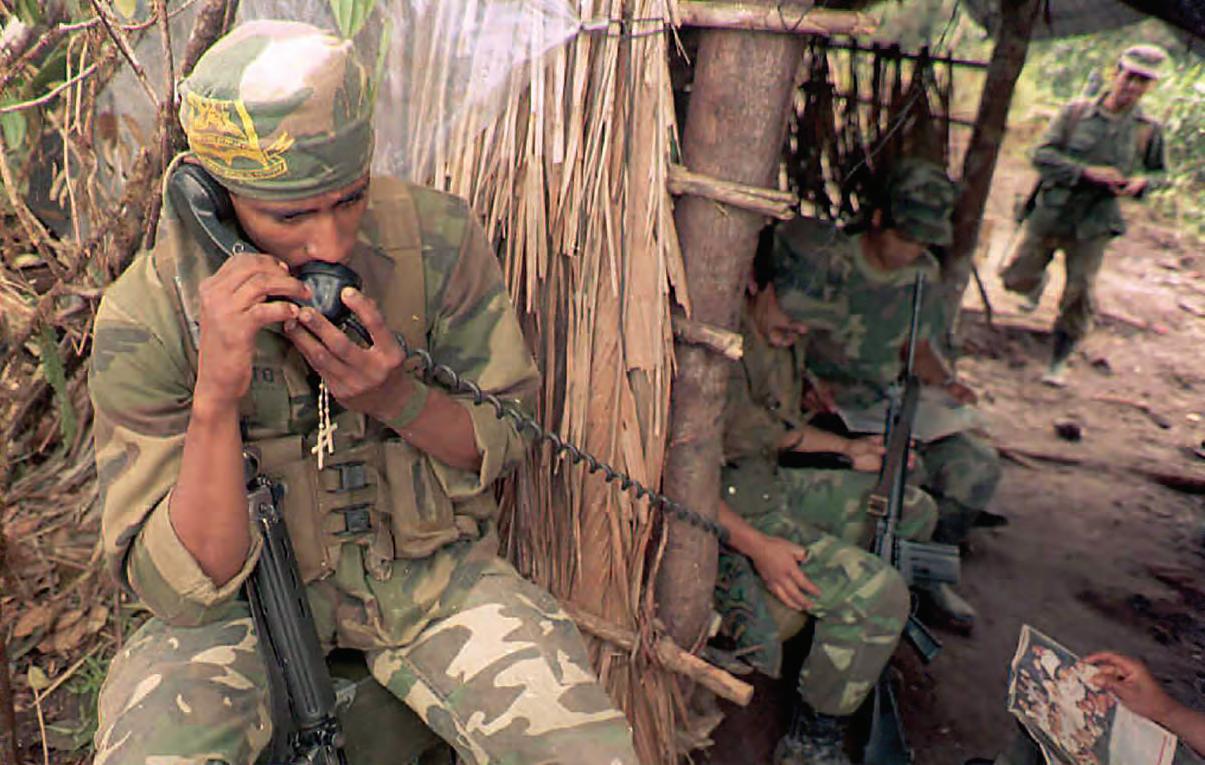
The Cenepa War, a fierce little fight of 34 days, was the latest in a series of wars between the South American neighbors over their disputed boundary. The two had most recently come to blows in 1941 and 1981. Ecuador had not defeated Peru since the 1829 Battle of Tarqui.

The dispute was a complex one, dating from Spain’s colonial rule, when Madrid oversaw most of Latin America through its Viceroyalties of Peru and New Granada and many smaller political units. Spain frequently changed the borders and responsibilities of the viceroyalties to ease the administration of its colonies and deal with Portuguese incursions along the Amazon River. One such change occurred in 1802 when a royal decree transferred much of what comprises present-day Ecuador to the jurisdiction of Peru. In 1803 another royal decree transferred jurisdiction
of the province of Guayaquil to Peru. Based on these decrees, Peru claimed the disputed lands on the legal principle of uti possidetis (as you possess, so shall you possess). However, in 1819 the Liberator, Simón Bolívar, through the Congress of Angostura, claimed the province of Quito (in present-day Ecuador) and parts of Jaén and Maynas provinces (in present-day Peru) for his Gran Colombia.
Ten years later an army under Marshal José de la Mar, president of a newly independent Peru, attempted to seize southern Ecuador. However, a Gran Colombian army under Grand Marshal Antonio José de Sucre beat back the Peruvians at the Battle of Tarqui and forced de la Mar to sign the Treaty of Girón, by which Peru recognized the boundary as it had existed in 1810. That treaty, however, did not resolve the dispute.
Over the next century Ecuador and Peru argued and sometimes battled one another for control of the disputed lands. At one point Peru seized the port of Guayaquil in retaliation for Ecuadorian incursions. Each sought to exploit the other’s internal political problems. On several occasions the parties asked the king of Spain to arbitrate. In 1936 the United States offered to arbitrate the dispute. Those efforts came to naught, and in 1938 Peruvian and Ecuadorian troops again engaged in border skirmishes.
In July 1941, taking advantage of the world situation and the United States’ distraction with events in Europe, Peru marched against Ecuadorian outposts in Casitas, Cero del Concho and elsewhere. The Peruvian commander, Brig. Gen. Eloy G. Ureta, was so insistent on an offensive operation that he’d threatened to march his troops against his own government were he not permitted to attack the Ecuadorians.
Peru greatly overmatched Ecuador in military might. It had modernized and reorganized its army, while Ecuador had not. Within weeks the Ecuadorian army was a fantasy. Although Peru suspended its operations to capture Guayaquil, abiding by the terms of a July 31 cease-fire between the belligerents, it nevertheless managed to seize the Ecuadorian province of El Oro.
In January 1942 the foreign ministers of Peru and Ecuador, together with representatives from the United States, Brazil, Argentina and Chile, hammered out the Rio de Janeiro Protocol, under the terms of which Peru evacuated El Oro province but retained control of Jaén, Maynas and Tumbes provinces.
That remained the status quo until Jan. 22, 1981, when Ecuadorian troops in the Cordillera del Cóndor of the Andes Mountains fired on a Peruvian reconnaissance helicopter. A day later they fired on another Peruvian reconnaissance chopper. Meanwhile, in the Cenepa Valley, Ecuadorian troops occupied three abandoned Peruvian outposts.

Ecuador justified its presence and actions, arguing that though the Rio Protocol had called for demarcation of their respective borders, that process remained incomplete, and unaccounted terrain features made what had been surveyed inaccurate. Thus, it argued, the 1942 agreement was invalid. Peru insisted the agreement did remain valid, and Ecuador had no legitimate complaint.

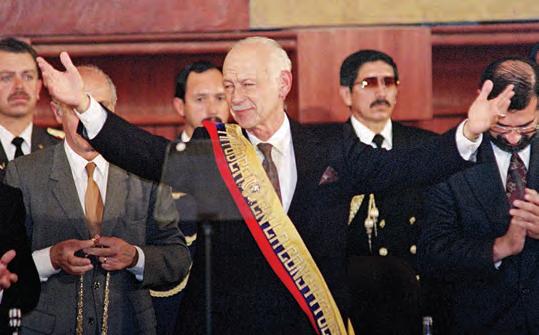
Peru, still militarily superior to Ecuador, resolved to retake its outposts and evict the Ecuadorians from the valley. Ever since its 1932–33 drubbing by Colombia over territory in the Amazon rainforest, Peru paid particular attention to its military: rebuilding it, retraining it, rearming it, and obtaining professional military advice from such European powers as France and Italy. In contrast, Ecuador used its military primarily to suppress internal unrest and failed to heed the threat posed by its historical enemy. In short, Peru prepared for war, Ecuador did not.
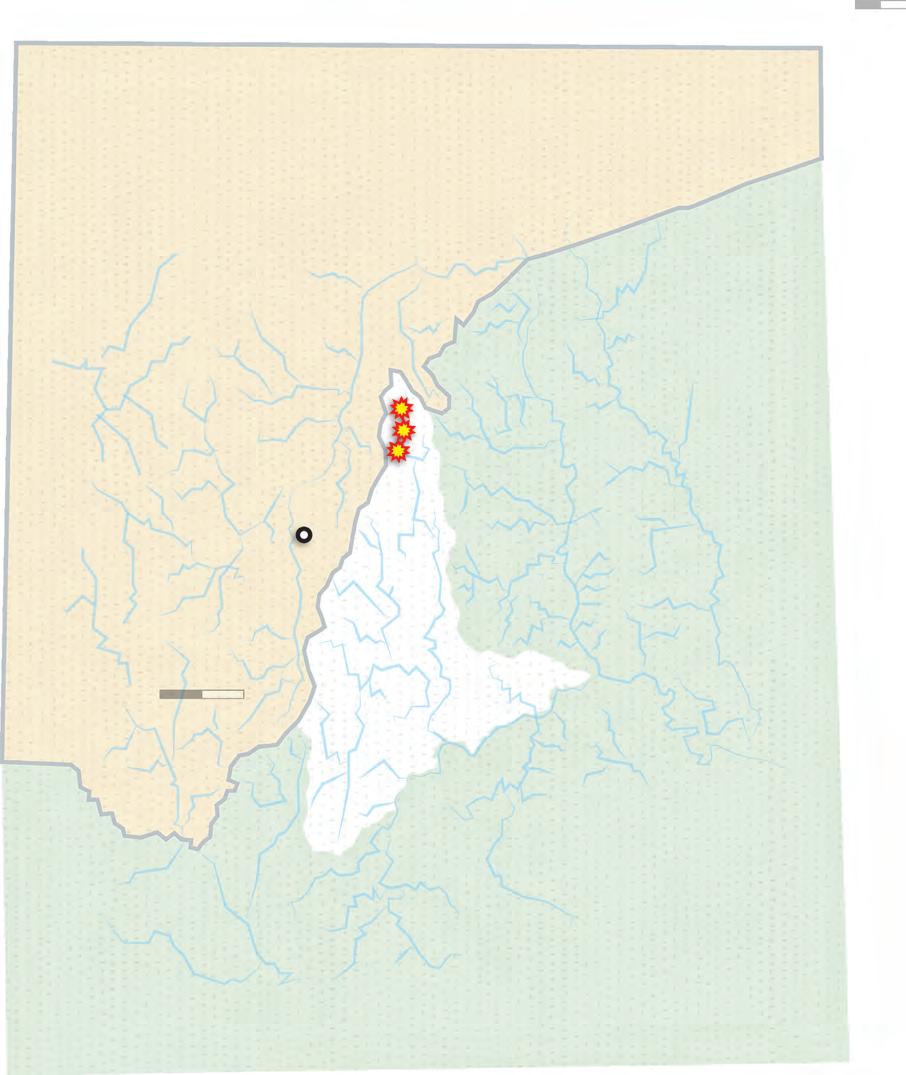
The results were painfully predictable and humiliating for Ecuador. At the outset of what became known as the Paquisha War, Peru twice attempted to assault the namesake Ecuadorian-held outpost before abandoning its efforts. On the third attempt, however, a Peruvian helicopter armed with rockets destroyed an Ecuadorian anti-aircraft battery, allowing helicopter-borne Peruvian soldiers to land

Ecuadorian air assets included the Kfir C.2 (at far left, top) and Mirage F1 (at left), here following a SEPECAT Jaguar. Below left: Peru lost three helicopters to Ecuadorian ground-to-air missiles. Below: Peru also lost an A-37B Dragonfly light attack aircraft.


and engage the Ecuadorians, driving them off after a short but intense firefight. A day later, on January 30, the Peruvians assaulted a second Ecuadorian outpost using attack helicopters and fighter-bombers. Landing air assault troops, the Peruvians quickly drove off the Ecuadorians. On February 1 the Peruvians recovered the third outpost.
The same scenario applied when the Peruvians attacked three more outposts occupied by Ecuadorian troops in the interim. Ecuador, lacking air support, was unable to respond and forced to abandon its positions and much of its
equipment. Each side lost more than a dozen killed and two dozen wounded.
Ecuador had learned its lesson. When it instigated the next war, in 1995, it came prepared. In early January Ecuadorians seized the high ground in the Cenepa Valley and dug in. They had modern weapons, including antiaircraft missiles and significant modern air assets, including French-built Dassault Mirage F1JA and F1JE fighters with air-to-air missiles and Israel Aircraft Industries Kfir C.2 and TC.2 fighters. They changed their tactics as well. Instead of directly confronting the Peruvians, as they had in the past, the Ecuadorians employed ambush and hit-andrun tactics, which one authority likened to tactics utilized by the Viet Cong in Vietnam. The Ecuadorian strategy was the same as in previous encounters in the disputed region: occupy positions Peru had abandoned in order to fight the Maoist Shining Path insurgency elsewhere. Ecuador would thus present a fait accompli to anyone interested, especially Peru. The challenge to Ecuador was to hold those positions.
The disputed area is roughly the size of the District of Columbia, less than 60 square miles, and lies approximately 50 miles east of the Ecuadorian city of Loja and 60 miles southeast of Cuenca. The Peruvian capital of Lima is about 600 miles to the south. The Cenepa River drains
Ecuador quickly established air superiority. Peru would lose a reported seven aircraft altogether
its watershed and ultimately sends its flow to the Amazon. The Cenepa basin is ringed by mountains, notably the Cordillera del Cóndor to the west. The very northern tip of the disputed area is a salient flanked by undisputed Ecuadorian territory. It is blanketed in dense jungle, some of which had never seen a human footprint other than those of the indigenous peoples. Indeed, many of those killed in the conflict weren’t found until years later, while others remain missing. Ecuador chose to begin offensive operations in this seemingly impenetrable salient.
Aided by Israeli advisers, Ecuadorian special forces units infiltrated and seized the Peruvian outposts at Tiwintza, Base Sur and Cueva de los Tayos, which were little more than clearings in the jungle large enough to accommodate a helicopter and a small garrison.
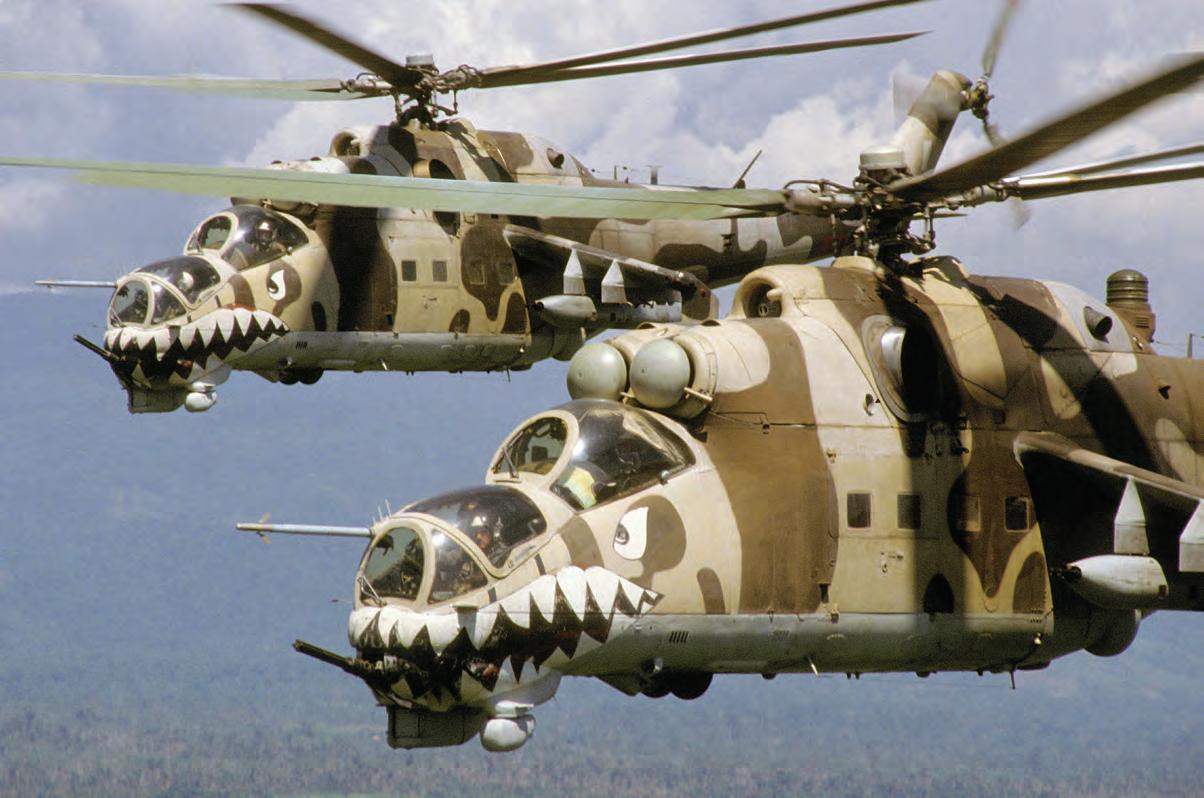
The Ecuadorians took position on high ground in the 6,500-foot Cóndor range. There they placed artillery that could effectively sweep the basin below and laid land mines to solidify their positions. They also made good use of the jungle canopy, which provided cover and concealment from Peruvian aircraft. The prevailing weather was also on their side. Cloud cover and rain often prevented effective use of the numerically superior Peruvian air assets. The Ecuadorians exploited their interior lines for good communication. They also used GPS to pinpoint targets and took a page from the U.S. Army’s AirLand Battle doctrine. Utilizing roads through the Cóndor mountains, the Ecua-
dorians made excellent use of their logistical support system. The Peruvians were limited to long-distance helicopter airlifts. Ecuador quickly established air superiority. Peru would lose a reported seven aircraft altogether: one medium bomber, two fighter-bombers, one light attack aircraft and at least three helicopters. The Ecuadorian air force suffered only damage to one light attack aircraft.
Peru’s military resources were numerically superior in almost every respect. But after more than 15 years of fighting Shining Path guerrillas, its army was worn down and dispirited. Once thought to be the most potent air force in Latin America, the Peruvian air force was a shell of its former self. It suffered from poor maintenance and a dearth of spare parts. Further, the Peruvian economy was in shambles, still reeling from longterm hyperinflation.
Though Simón Bolívar is memorialized as the “Liberator” who freed what would become Peru and Ecuador from Spanish colonial rule, he ironically sowed the seeds of the Cenepa War via territorial claims when carving out his idealistic united state of Gran Colombia in 1819.
Peruvian President Alberto Fujimori was keenly aware his military was in poor shape to fight anyone. Indeed, he met with Ecuadorian President Sixto DuránBallén to advise him Peru would be withdrawing some of its forces in the Cenepa basin to commit them to the fight against the Shining Path. He expressed his hope Ecuador

would understand and not take advantage of the situation but maintain the peace. Unfortunately for Fujimori, Ecuador did take advantage of the situation. It would suffer no further humiliation. As one regional expert put it, Ecuador’s 1941 loss of access to the Amazon “went against the Ecuadorian soul.”
By mid-February Peru had recaptured the outposts at Base Sur and Cueva de los Tayos, but they were unable to recapture Tiwintza. The Ecuadorians, aided by their artillery high in the Cóndor range, refused to yield.
Despite its maintenance issues and lack of spare parts, the Peruvian air force flew as many as 16 sorties per day against Ecuadorian positions, but at a price. Ecuadorians armed with ground-based weapons, including the Britishmade Blowpipe shoulder-fired missile, shot down several Peruvian helicopters and attack aircraft. On February 6 a Peruvian English Electric Canberra B.68 bomber was lost with all aboard when it flew into the side of a mountain, apparently due to poor weather conditions. In an air-to-air battle on February 10 two Ecuadorian Kfir C.2s intercepted several Peruvian U.S.-built Cessna A-37B Dragonfly light attack aircraft and downed one, while two Ecuadorian Mirage F1JAs shot down two Peruvian Sukhoi Su-22M attack aircraft, though Peru denied the latter two were combat losses.
Despite their setbacks, the Peruvians were able to muster a task force of 2,500 men to recapture the outposts. By late January, supported by Soviet-built T-55 tanks and artillery, they launched a counteroffensive against the Ecuadorian positions. Again the Ecuadorians avoided direct conflict by using ambush and hit-and-run tactics.


A problem faced by ground-attack aircraft of both air forces was the asymmetrical nature of the battlefield. Peruvian pilots in particular had difficulty distinguishing between friendly and enemy positions. For the most part the war was fought by platoon-sized elements. There were no “front lines.” A Peruvian unit might have an Ecuadorian platoon to its rear or vice versa. When the combatants finally agreed on a cease-fire and their respective armies

Ecuador’s successful use of modern technology proves a small state can fight a larger one
were to disengage, the effort took more than two months due to the battlefield asymmetry.
“Clearly, Ecuador holds the key terrain,” one military analyst noted. “I know they have sufficient firepower, so that if they really wanted to take out the Peruvians, they could do so.…Ecuador can hold out for a long time.”
It didn’t have to. By early March both sides had agreed to a U.N.-brokered cease-fire calling for the separation of the combatants, demobilization of their armies, substantive negotiations and a normalization of diplomatic relations.
The butcher’s bill for the conflict came to a reported 34 killed for Ecuador and 60 for Peru. The war was estimated to have cost $1 billion.
Though sporadic fighting broke out, generally the cease-fire held. Not until 1998 did the four original guarantors of the 1942 Rio de Janeiro Protocol—Chile, Brazil, Argentina and the United States—hammer out a permanent solution. Even then, the agreement was only possible because both Ecuador and Peru had significantly altered their long-held positions. Ecuador, in a massive sea change, agreed to work within the parameters of the Rio Protocol. Likewise, Peru reversed its long-held position there was no legitimate dispute.
The negotiations almost came to an abrupt halt when Ecuador buried its war dead in a cemetery it had created within the disputed zone. After months of negotiation on that issue alone, the guarantors devised a compromise by which the cemetery was deemed owned by Ecuador but under Peruvian sovereignty. Peru, in turn, agreed to give up any right to confiscate Ecuadorian property. The parties also agreed the area should be a demilitarized zone, and peacekeeping troops from the guarantor nations were to deploy in the zone as observers. Finally, Peru agreed to Ecuador’s unfettered access to the Amazon River. Both parties signed the Brasilia Presidential Act on Oct. 26, 1998, thus putting a definitive end to a more than 150 years of dispute.
Ecuador emerged the victor. Some commentators call it a stalemate, but the fact remains Ecuador was not, as the Peruvians had long intended, ejected from the Cenepa basin, but left of its own accord under the cease-fire protocol. It had prevailed by careful planning, improved logistics, shrewd choice of terrain and the use of modern technology, and after having revamped and rearmed its military. As Ecuadorian President Durán-Ballén stated, the victory was due to 14 years of military preparation since the 1981 debacle.
The Cenepa War has changed international thinking in several ways. First, it dispelled the long-held view that democracies don’t war with other democracies. Clearly, they can and do if the circumstances and national interests are right. Second, Ecuador’s successful use of modern technology proves a small state can fight a larger one on equal terms, thus presenting a real deterrent to its larger neighbor. Third, the war destroyed the notion Latin America has become a generally peaceful region not requiring close attention by
third parties, such as the United States. U.S. foreign policy ignores Latin America at its peril.
Durán-Ballén emerged as one of Ecuador’s most popular presidents and elder statesmen, though scholars debate the legacy of his presidency. He died, much revered by the Ecuadorian public, at age 95 in 2016.
Although his administration defeated the Shining Path insurgency, significantly improved the economy and won re-election in April 1995 by a wide margin, President Fujimori became increasingly authoritarian. Facing charges of corruption and human rights abuses in 2000, he fled to Japan. Then, on a 2005 visit to Chile, he was arrested and later extradited to Peru. In 2007 Fujimori was convicted of illegal search and seizure, and two years later he was convicted of embezzlement, bribery and human rights violations, including the use or approval of death squads and torture. He is serving a 25-year prison sentence. Fujimori’s son, Kenji, served as a member of the Peruvian Congress from 2011 to 2018. His daughter, Keiko, ran for the presidency in 2011, 2016 and 2021, but was defeated each time. MH
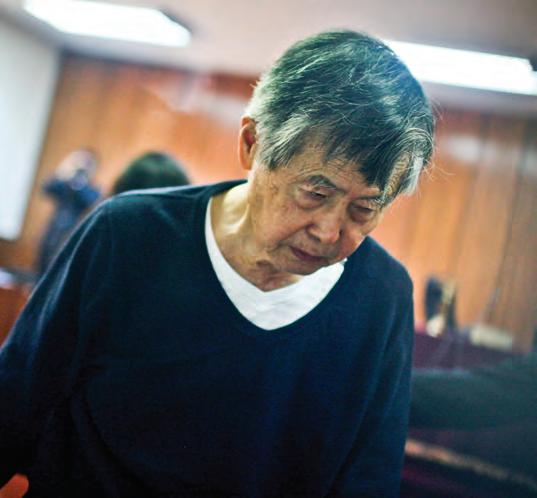
TROOPS KILLED
70 WOUNDED
1 AIRCRAFT DESTROYED
AT-33A (TO AN ACCIDENT) PERU 60 TROOPS KILLED
400-PLUS WOUNDED
4
AIRCRAFT DESTROYED
SU-22 (2), A-37B (1), CANBERRA (1)
3
Jerome Long is a former instructor at the U.S. Army Command and General Staff Officers’ Course who taught classes on such topics as military intelligence, operational warfare and military history. For further reading he recommends Latin America’s Wars, Vol. II: The Age of the Professional Soldier, 1900–2001, by Robert L. Sheina, and Air Wars Between Ecuador and Peru, Vol. 3: Aerial Operations Over the Cenepa River Valley, by Amaru Tincopa.
HELICOPTERS DESTROYED
MI-8T (2), MI-25 (1)
Major Patrick Ferguson earned his nickname for his dogged determination to remain in the American Revolutionary War and bring the upstart Patriots to heel
By John MilesOn Oct. 7, 1780, Ferguson’s Loyalist militia, depicted above on the defensive, was bested by inferior numbers of hardscrabble Patriots known as the “Overmountain Men” at the Battle of Kings Mountain in the Carolinas. Ferguson’s only defeat proved his last fight.


It was 1760, in the midst of the Seven Years’ War, and 16-year-old Cornet Patrick Ferguson was having the time of his life. He and another young officer were on horseback a few miles out in front of the British army when they ran afoul of a party of French-allied German hussars. Deciding it prudent to retire, they turned and spurred their mounts. As his horse jumped a ditch, Ferguson dropped one of his pistols. The naive lad, thinking it improper for an officer to return to camp without all his weapons, recrossed the ditch in the face of the pursuing enemy and dismounted to recover his pistol. The hussars, perhaps surmising a British dragoon wouldn’t be so foolhardy unless he had spotted friendly reinforcements, halted in their tracks. They looked on warily as Ferguson remounted, jumped his horse back over the ditch and joined his companion. The fortunate young men regained the British camp undisturbed. Though Ferguson seemed to lead a charmed life in uniform, such reckless behavior in action would one day catch up to him.
Patrick Ferguson was born in on June 4, 1744, in Pitfour, Aberdeenshire, Scotland, the son of a titled and well-connected lawyer. The Fergusons had a long tradition of military service, and from childhood Patrick resolved to pursue a career in the army. Accordingly, when the boy reached the tender age of 12, his father sent him to a military academy in London. At that time in European history a gentleman desiring to be an officer in the military could purchase his commission from a regimental commander. From there he might earn merit-based promotions, but he could also purchase ranks in turn. Fer guson’s father purchased his son’s first commission, as a cornet in the 2nd (Royal North British) Dragoons (aka “Royal Scots Greys”), when Patrick was just 14. Dragoons were mounted infantry, who rode horses into battle and then fought on foot. In 1760 Ferguson’s regiment deployed to continental Europe, where he got his first taste of combat in Flanders and Germany and lived to tell of his close encounter with hussars.
In 1768, though Ferguson had cut his teeth with eight years of service, his father again purchased a commission for him, as a company commander in the 70th (Glasgow Lowland) Regiment of Foot, then serving in the West Indies. Late that year Captain Ferguson sailed to join his company in Tobago. Attuned to the well-being of his men, he had them take advantage of the tropical climate and grow vegetables as a supplement to their usual provisions of salted beef. While there, however, Ferguson himself contracted

what was probably extrapulmonary tuberculosis. Related tubercular arthritis racked his knees with pain for the remainder of his life. After a brief stopover in the North American colonies, Ferguson returned to Britain in 1774.
By then it was clear that unrest with oppressive taxation and domineering British governance was approaching a breaking point in the American colonies. When British officers spoke among themselves, one oft-discussed point of concern was the colonials’ possession of precision hunting rifles—not in terms of numbers of weapons, which was not great, but because in the hands of skilled marksmen they were deadly at long range. In the event of war, of course, British officers would be the favored targets of such sharpshooters.
The standard long arm in the British military of the era was the “Brown Bess” muzzle-loading smoothbore flintlock musket, though it was notoriously inaccurate. An 1841 Royal Engineers test of the Brown Bess (in service from 1722 till 1838) recorded hits on man-sized targets at 150 yards only 75 percent of the time. Beyond that range the musket failed to hit even larger targets. Its point-blank range—the distance at which a round remains on a horizontal line of flight—was just 75 yards.

The rifle, while more accurate, also had its drawbacks. Foremost was its slow reload time. While an adept soldier with a musket could fire some three to five rounds a minute, with a rifle he might manage only one or two shots a minute.

Most rifles also had no means of attaching a bayonet, at a time when bayonet charges often proved decisive.
In set-piece battles of the day opposing armies lined up opposite one another, approached within effective range, fired by volley, then reloaded and repeated. Given the unlikelihood of scoring a hit, the line infantry drilled to reload as fast as possible and put more lead in the air, improving their odds. This madness continued until one side or the other appeared vulnerable, at which point the side sensing an advantage would launch a bayonet charge to finish the fight. Thus muskets, given their rate of fire and the ability to mount a bayonet, remained the long arm of choice for the rank and file. Realizing the limitations of his weapon, each soldier generally aimed at an enemy formation and hoped to hit someone, anyone. But soldiers tasked with reconnaissance and surveillance, such as the German Jägers, preferred rifles. Tasked with observing and reporting on the enemy from a distance, they required a weapon with longrange accuracy. God help them were they in bayonet range.
On his return to Britain in 1774 Captain Ferguson resolved to develop a faster-loading service rifle than those in use. If he could do so, it would eliminate the hidebound British military’s primary reasons for retaining the wildly inaccurate smoothbore. European gunmakers started experimenting with rifling as early as 1498, originally applying
grooves to the insides of barrels in order to collect fouling. The black powder propellant of the era left a tremendous amount of residue, about 80 percent of the powder in each charge remaining behind to foul the weapon. Stabilizing the bullet was a happy and unexpected side effect of adding the rifling. If Ferguson could conceive of a faster action and add a bayonet lug to his new rifle, all the better. After searching for technological advancements and examining a range of existing weapons, he settled on a breechloader. Breech-loading rifles had been in regular use for decades prior to Ferguson’s interest. What he did do was use his force of will, coupled with his family connections as minor nobility, to oblige senior military officers to listen to his proposals. Using family money, the captain contracted with the head armorer at the Tower of London to design a breechloader according to his specifications. After a period of trial and error, the Ferguson rifle was born. It centered on an innovative screw breech (see P. 69). With a working model in hand the inventor again wielded his political connections to arrange a demonstration for Lord George Townshend, master general of the Ordnance, and senior British officers. After

winning them over, Ferguson was invited to Windsor Castle to demonstrate the rifle before King George III himself.
During his tests Ferguson was able to fire between four and six shots a minute and hit the bull’s-eye consistently at 200 yards. He was also able to reload his breechloader from the prone position, an impossibility for musketeers, as they had to at least kneel to pour powder down the barrel and manipulate a ramrod to force a ball down the muzzle. Ferguson simply rotated the trigger guard to open the screw breech and poured in powder, all from the ground. In a further demonstration of his rifle’s merits, he doused the loaded breech with water. In the black powder era a soggy charge wouldn’t fire—hence the expression, “Keep your powder dry.” To remove a wet charge from a musket, its owner had to thread a steel screw on the end of his ramrod, drive it down the barrel until it hit the ball, twist the screw into the soft lead, pull out the ball, dump the wet powder and then reload. The tedious process required the assistance of another person, to either hold the musket or manipulate the ramrod. In the midst of combat such fumbling might well prove fatal. Ferguson was able to screw open his breech, tap out the damp charge, add dry powder and screw it closed, again while remaining prone.
Duly impressed, his superiors placed an order for 100 Ferguson rifles and assigned the captain command of a light infantry unit, to be armed with his breechloader and employed in the American colonies, by then in open rebellion against the Crown. The men in his command would be volunteers, drawn from the assorted regiments already serving in the colonies.

While Ferguson prepared to ship overseas, a complication arose. As the Industrial Revolution remained in its earliest stages, Britain lacked factories able to mass produce firearms. Each weapon had to be produced individually by a gunsmith. Furthermore, fabricating the lands and grooves inside a rifle barrel was labor intensive, taking far longer to complete than the smoothbore barrel of a musket. Even with multiple gunsmiths working to create Ferguson’s rifles, there were nowhere enough to complete the 100 ordered weapons before he embarked.
In the end only 67 of Ferguson’s rifles were ready by the time he left in March 1777 to join Maj. Gen. Sir William Howe’s army in North America. On arrival the captain traveled among the various regiments to demonstrate the rifle and recruit 100 soldiers for his command. Finally, he began training his enlistees how to operate as light infantrymen armed with rifles. Due to the shortage of his namesake gun, Ferguson had to arm the remainder of his troops with traditional muzzle-loading rifles already in
use; the remaining 33 Ferguson guns shipped from Britain that June. When he deemed his men ready, Ferguson was assigned to Hessian Lt. Gen. Wilhelm von Knyphausen’s command, then in New York.
The Ferguson rifle was about to get its trial by fire.
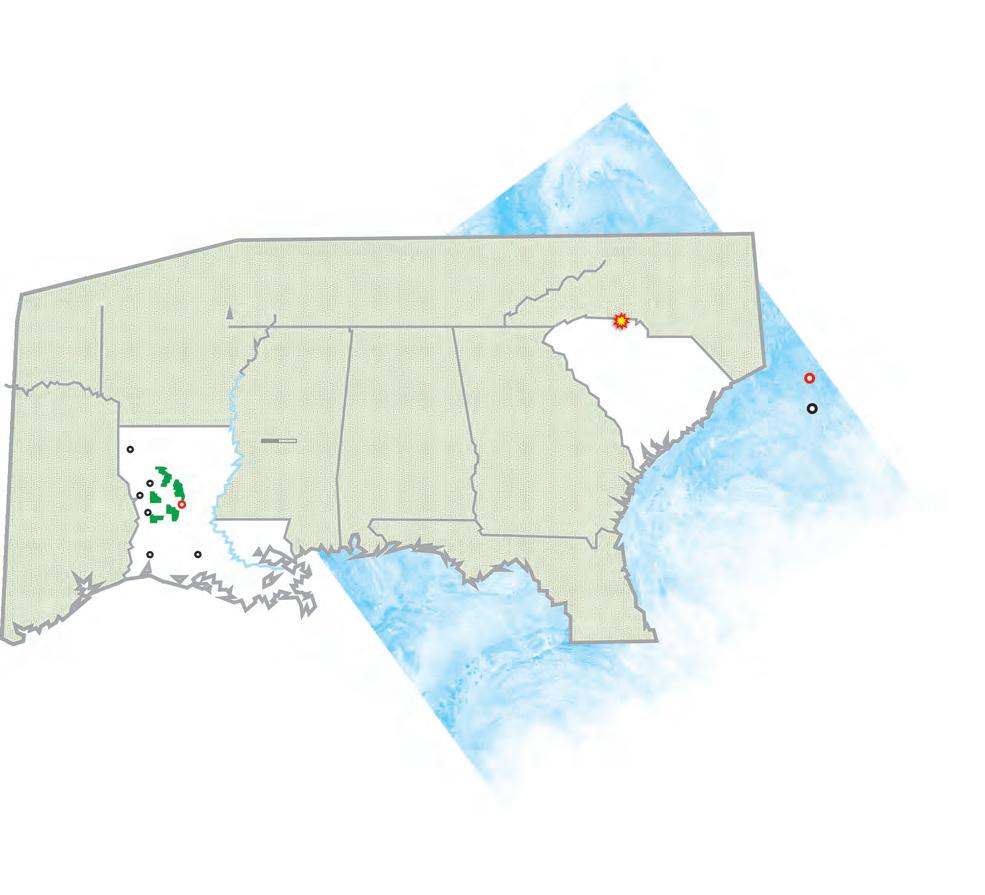
On Sept. 11, 1777, during the British campaign to capture Philadelphia—then capital of and largest city in the nascent United States—Howe’s British army met General George Washington’s Continental Army near Chadds Ford, Penn. The subsequent Battle of Brandywine was the second longest single-day battle of the war, with continuous fighting lasting 11 brutal hours. More troops fought at Brandywine than at any other battle in the North American theater of the war. Marching in the vanguard, Ferguson’s rifle corps was tasked with screening the main British army, so American forces couldn’t get a clear picture of Howe’s plans. The resulting British victory enabled Howe to capture Philadel-

Top: The Overmountain Men got word of Ferguson’s approach and surrounded his men at Kings Mountain. By then his rifle, its clever screw breech depicted above, had been dispersed to other units.

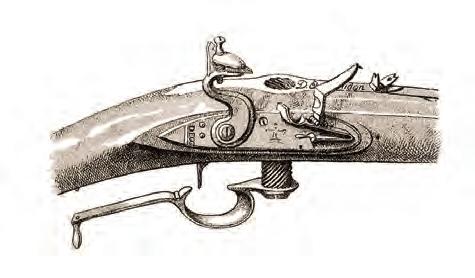


phia two weeks later, prompting the Continental Congress to flee, first to Lancaster and then York, Pa.
Although his rifle corps performed its tasks admirably at Brandywine, Ferguson had been struck by a musket ball that shattered his right elbow, a wound that sidelined him from active duty for some months as he recovered. All things considered, he was fortunate. In the days before orthopedic trauma care, a wound such as he’d received would often lead to amputation, or at least medical retirement from the military. Ferguson refused to have his arm amputated, and he quite literally wouldn’t surrender his officer’s sword. Since the shattered elbow cost him full use of his arm, the right-handed major taught himself to wield his saber left-handed. It was such single-minded
dedication and dogged determination that earned Ferguson the nickname “Bulldog.”
Brandywine was uniquely linked to Ferguson for another incident—one that proved among the most remarkable and enduring stories (or perhaps legends) of the war.
While he and his men were engaged in screening duties far in advance of British lines, Ferguson observed two American officers conducting a similar reconnaissance of the British. One was mounted on a bay horse and wore an especially
Ferguson could give the order to fire, he again had second thoughts. The American officers posed no immediate threat to the British, and it certainly wouldn’t be sporting to have them shot in the back, so he had his riflemen stand down.
large bicorne hat. The officers appeared unconcerned, as they remained well out of musket range. They were not out of rifle range, however, and Ferguson ordered three of his men to prepare to fire. Harboring reservations, Ferguson thought it advantageous to try and capture the American officers. Thus, he stepped into the open and called for them to ride toward him and surrender, or he would have his men shoot. At that, the Continentals simply turned their horses to ride away. Being out of musket range, they didn’t even feel it necessary to spur their mounts beyond a walk. Before
Later that day, when Ferguson was at the field hospital getting treated for his elbow wound, he struck up a conversation with a British surgeon who had also treated several wounded American officers. From details the surgeon gleaned from the wounded captives it seemed the two officers Ferguson had spared were none other than General Washington and an aide-de-camp. Lieutenant John P. de Lancey, Ferguson’s second-in-command, who had seen Washington before the war, later suggested the enemy officer in the cocked hat had been Brig. Gen. Casimir Pulaski, the Polish volunteer credited as the “father of American cavalry.” Whether it was Pulaski or Washington, and Ferguson had missed his chance to end the war on the spot, he later wrote that he didn’t regret his decision.
While the Bulldog was recovering from his injury and mourning the death of his father back in Britain, the British were formulating a new strategy for their campaign in North America. The first few years of the war had primarily been fought in New England and mid-Atlantic colonies, and though the British had won most of the battles, they had yet to deliver a knockout blow. Meanwhile, the populace back home had grown increasingly weary of sending off their
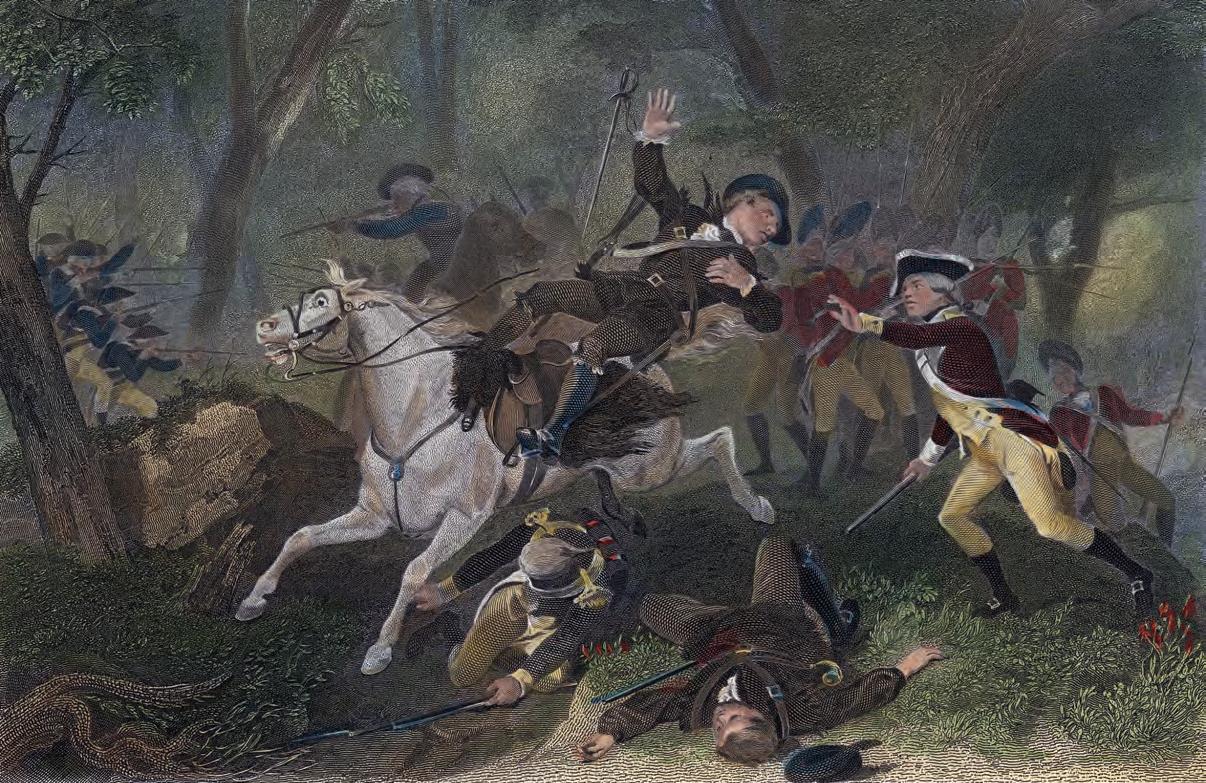
Despite being wounded and having horses shot from under him, Ferguson continued to fight
sons and spending their tax money to fight a seemingly endless war. Thus, in late 1778 Lt. Gen. Sir Henry Clinton launched a campaign in the South, hoping to spark an uprising of Loyalists, colonists born in North America but remaining loyal to the Crown. Were that successful, Clinton hoped to force the Americans to capitulate. The campaign began auspiciously enough with the capture of Savannah, Ga., that December 29, which the British successfully defended in October 1779. The day after Christmas Clinton and his second-in-command, Lt. Gen. Charles Cornwallis, left Knyphausen to garrison New York City and sailed for Savannah with a substantial army.
Having recuperated enough by then to return to active duty, Ferguson was commissioned a major in the 70th Regiment of Foot and embarked with the expedition. In the absence of its dynamic founder, however, Ferguson’s rifle corps had disbanded, its men returning to their original regiments, their rifles either put in storage or parceled out to other units. The major returned to service without a command to lead.
Regardless, his superiors recognized Ferguson’s leadership ability, and Cornwallis gave him command of a battalion of provincial Loyalist militia. In that capacity Major Ferguson would participate in the largest all-American battle of the war.
From Savannah the British army marched north to Charleston, S.C., which Clinton captured on May 12, 1780, after a six-week siege. He then returned to New York, tasking Cornwallis with subjugating the Carolinas. By summer Cornwallis had pushed north to Charlotte, N.C., and was concerned about protecting his flank. The threat he envisaged came from “Overmountain Men,” hardscrabble frontiersmen from west of the Blue Ridge Mountains, the leading edge of the Appalachian Range. Cornwallis assigned Ferguson’s battalion to counter the threat posed by the Patriot riflemen. The stage was set for the Battle of Kings Mountain.
Resolving that the best defense was a good offense, Ferguson departed Charlotte for the Appalachian reaches. According to American sources, en route Ferguson captured a Patriot and had the man relay a message to the “Backwater Men,” as the British called their foes west of the Blue Ridge. They were to lay down their arms in surrender, Ferguson warned, or the British would burn their farms and villages and hang their leaders. Whether those were truly Ferguson’s words or shrewd Patriot propaganda is unknown. As the message wasn’t written down, it cannot be proved or disproved. Regardless, at word of the threat the Overmountain Men mustered a superior force to repulse Ferguson’s militia. On September 30 Patriot deserters brought word of the onrushing American force. Ferguson gave the order to fall back on Cornwallis’ main army at Charlotte. He made it as far as Kings Mountain, straddling the border of North and South Carolina some 30 miles west of Charlotte.
On Oct. 7, 1780, an advance party of 900 Overmountain Men on horseback surrounded Kings Mountain and attacked Ferguson’s command. Though caught by surprise
Ferguson is buried where he fell, beneath the stone cairn behind this marker at Kings Mountain National Military Park, near Blacksburg, S.C. He shares the grave with one “Virginia Sal,” possibly a camp follower.

and soon in desperate straits, the major rode back and forth among threatened points, repeatedly leading his men in bayonet attacks to repel the determined frontiersmen, who fought independently by detachment. Despite being severely wounded and having multiple horses shot from under him, Ferguson continued to fight and animate his men by example. Toward the end of the battle his second-in-command earnestly recommended the major surrender. Ferguson refused and in short order received a fatal rifle shot to the chest. Survivors later counted seven bullet wounds on his body. It was an abrupt end to a promising military career at age 36. In a battle that lasted just over an hour, 290 of Ferguson’s Loyalists were killed, 163 wounded and 668 captured, while the Patriots suffered 28 killed and 60 wounded. In its wake Cornwallis abandoned his ambitions in North Carolina and withdrew south.
Patrick Ferguson was buried on the spot along with a female companion named “Virginia Sal,” who was possibly his mistress. Their shared grave was marked by a stone cairn that still stands in present-day Kings Mountain National Military Park. MH
Battle of Kings Mountain
OCT. 7, 1780
900 PATRIOTS
28 KILLED 60 WOUNDED
1,105 BRITISH LOYALISTS
290 KILLED 163 WOUNDED, 668 CAPTURED
Retired U.S. Marine Colonel John Miles writes and delivers lectures on a range of historical topics. For further reading he recommends Every Insult and Indignity: The Life, Genius and Legacy of Major Patrick Ferguson, by Ricky Roberts and Bryan Brown; Biographical Sketch: Or, Memoir of Lieutenant Colonel Patrick Ferguson, by Adam Ferguson; The Philadelphia Campaign: Vol. 1: Brandywine and the Fall of Philadelphia, by Thomas J. McGuire; and Kings Mountain and Its Heroes, by Lyman C. Draper.
The popular conception of the end of World War II is that the Americans dropped two atomic bombs on Hiroshima and Nagasaki, after which Japan surrendered. Events, however, were not as simple as that. Barrett Tillman’s When the Shooting Stopped recounts the dramatic and complex events that took place during the war’s final month.
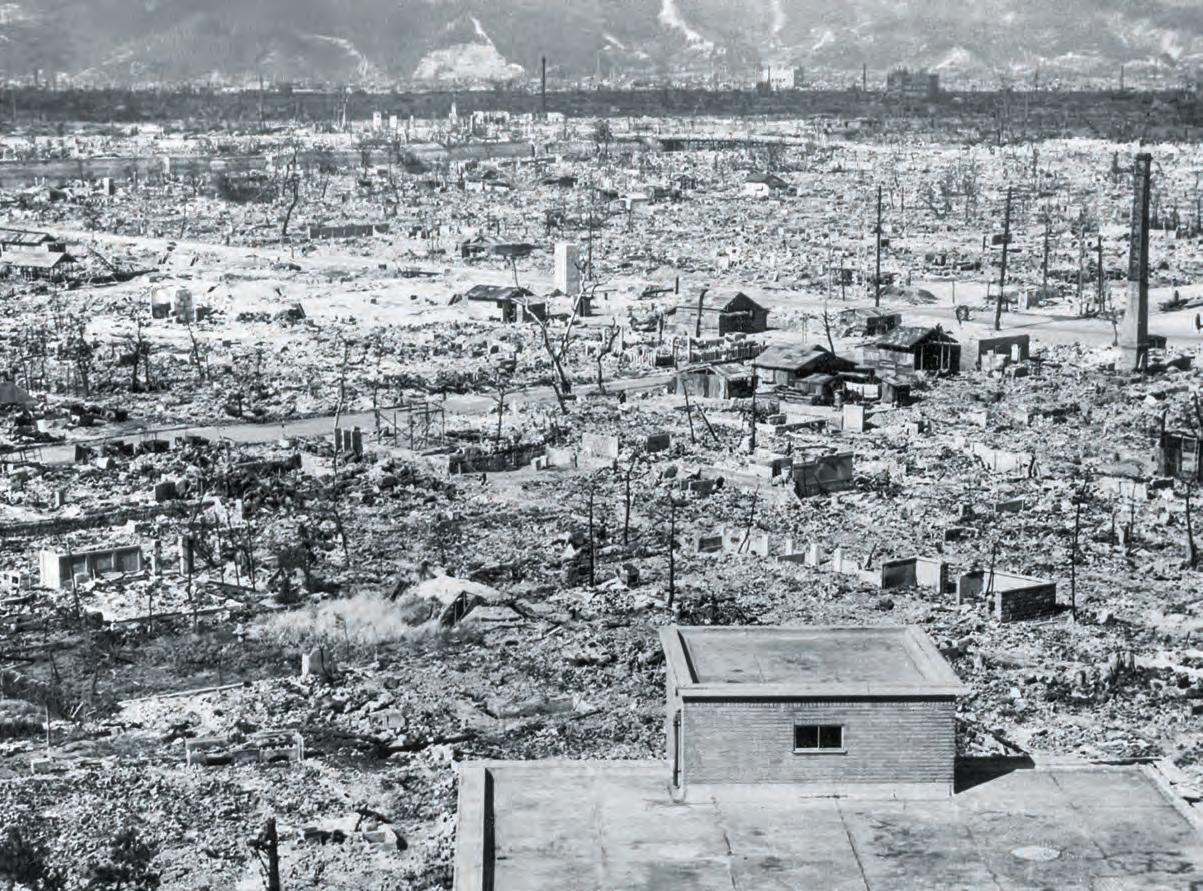

As Tillman explains, momentous changes were put in motion at the July 17–Aug. 2, 1945, Potsdam Conference, changes that would determine the course of the postwar world for decades to come. Amid the conference Winston Churchill, Britain’s prime minister since 1940, was voted out of office and replaced by Clement Attlee. Potsdam was also the first international summit conference attended by newly inaugurated U.S. President Harry Truman, and it was during that conference
Truman was informed for the first time about the successful test of the atomic bomb.
Meanwhile, despite the tightening of the Allied noose around the Home Islands, the Japanese were no closer to capitulation, ignoring Allied surrender demands, warnings of imminent catastrophe and even the bombing of Hiroshima. On the very day Nagasaki was bombed, the Soviet Union attacked the Japanese in Manchuria and Korea, something Joseph Stalin had agreed to do at the Yalta Conference that February.
This fascinating new book provides a detailed day-by-day chronicle of the war’s final days, replete with firsthand accounts from those who took part. Tillman also relates Japan’s difficult postwar transition and the part played by Douglas MacArthur in that process.
—Robert GuttmanIron and Blood: A Military History of the German-Speaking Peoples Since 1500,
by Peter H. Wilson, Belknap Press, Cam-bridge, Mass., 2023,
$39.95What exactly is the muchheralded “German way of war”? In his new book, Iron and Blood, British historian Peter H. Wilson argues convincingly there has never really been such a thing. Rather than focusing, as does much contemporary analysis, on the dominance of Prussia from the wars of German unification of the late 19th century through World War II, Wilson takes a much longer view. He starts with the consolidation of the Holy Roman empire in the late 15th century. Instead of centralization, the prevailing pattern is one of relative autonomy
tions. “Balancing War and Peace” covers the 16th century and the ad hoc armies that fought the seasonal wars of the period. “Accepting War As Permanent” deals with the period starting with the Thirty Years’ War and the growth of standing armies up through the 18th century. “Professionalizing War” discusses the revolutionary through the immediate postNapoléonic periods, when officership became a pro fession, rather than a right of social status. “National izing War” focuses on the latter half of the 19th cen tury through World War II and the increasingly central izing influence of Prussia. “Democratizing War” covers the post-1945 experiences of West and East Germany.
Iron and Blood is not, how ever, a strict chronological survey of wars, battles and leaders. Within each of the five major sections the chap ters address key thematic topics, such as the relation between war and politics; the recruitment, organization, equipment, training and command of forces; the motivation and legal status of soldiers and their relation to the broader society; and the demographic and economic aspects of warfare.

Between their forced arrival in colonial America aboard slave ships to their official acceptance in a desegregated U.S. Army during the Korean War, the history of black Americans in the military could be summarized as having proved their mettle in one war, only to have to prove
 By Angus Konstam
By Angus Konstam
Varying in time and place from the 480 bc Battle of Thermopylae to Operation Desert Storm in 1991, Scottish historian Angus Konstam’s compilation of 100 Greatest Battles—each heralded by colorful artwork—examines the importance of each battle and how weapons and tactics have evolved over time. Konstam makes his case for those clashes with long-term economic or political ramifications or ones whose technical innovations changed the face of combat itself. Yet
son notes in his introduction, “To date, discussions of the ‘German way of war’ have focused almost exclusively on how war was conducted once hostilities commenced, rather than the often-long periods of relative peace.”
The book is divided chronologically into five major sec-
Nothing like this book exists in English. It is a mustread for anyone seriously interested in European history in general and military history in particular.
—David T. Zabecki by Eugene DeFriest Bétit, Stackpole Books, Essex, Conn. and Blue
by Eugene DeFriest Bétit, Stackpole Books, Essex, Conn. and Blue
standing fighting men, such as the 1st Rhode Island Regiment in the Revolutionary War, New Orleans’ Free Men of Color in the War of 1812, the 54th Massachusetts Infantry during the Civil War, the “Buffalo Soldiers” of the 9th and 10th Cavalry and 24th and 25th Infantry regiments during the Indian wars, the 369th Infantry in World War I and the “Tuskegee Airmen” of the 332nd Fighter Group in World War II.
Yet, with each new conflict for which they volunteered, they encountered the same obstacles from those racist white superiors who claimed they lacked the intelligence, strength and courage to be useful soldiers—and if their performance contradicted such suppositions, the
 By Mark Galleotti
By Mark Galleotti
Mark Galleotti relates the 1283–1422 Lithuanian Crusade between the Catholic warriors of the Teutonic Order and the pagan Grand Duchy of Lithuania, revealing how their struggle changed from a holy war to an ethnic clash between Germanic and Slavic cultures. Along the way he assesses their weapons and tactics at Voplaukis (1311), Kaunas (1362) and Grunwald (1410).
brass didn’t want to know about it. Still, manpower needs in each successive war since the Revolution compelled the Army and Navy to enlist black soldiers, and they rose to each occasion —only to return home to inequality and an attitude of, Yeah, but what have you done for us lately?
Eugene DeFriest Bétit’s book Unsung Patriots is not an eye-opening history so much as an update. There have been numerous previous accounts on the deeds of black units and individuals in combat, but the past few decades have seen them add to their laurels in new battle fronts, while a number of deserving soldiers, like Henry Johnson, Freddie Stowers and Paris Davis (see P. 8), have had recognition of their heroism upgraded to the Medal of Honor.
—Jon Guttman
Prisoners of the Castle: An Epic Story of Survival and Escape From Colditz, the Nazis’ Fortress Prison, by Ben Macintyre, Crown, New York, 2022, $28.99

The New York Times has referred to Ben Macintyre as “John le Carré’s nonfiction
counterpart,” and on one level Macintyre’s Prisoners of the Castle is a suspense story centered on successive Allied escape attempts from the German prisoner of war camp at Saxony’s Colditz Castle. However, Macintyre argues there is more to the story than the escape attempts, German countermeasures and surrounding myths. “Life in Colditz,” he writes, “was about more than escaping, just as its inmates were more complicated, and far more interesting, than the cardboard saints depicted in popular culture.” For example, the author describes double amputee Spitfire ace Douglas Bader as “living evidence that it is possible to be courageous, famous, disabled and quite unpleasant all at the same time.”
In a similar vein Macintyre devotes attention to the personalities and quirks of Colditz’s warders: bibulous captain of the guard Hauptmann Paul Priem; prim and pedantic but brilliant camp security chief Reinhold Eggers; and strict Kommandant Edgar Glaesche, a veteran of the Eastern Front. Throughout the narrative Macintyre focuses on the human element.
Macintyre also considers the social drama that played out within the walls of Colditz, notably national rivalries and class divisions within the ranks of British prisoners, particularly between officers and their enlisted orderlies. There were traitors and moles within the population, while MI9, the branch of British military intelligence assigned to develop POWs as military as-
sets, was also at work. Such illustrations only scratch the surface of the complex society Macintyre documents.
Over four and a half years thousands of prisoners spent millions of man-hours confined in the castle. While the planning and preparation for escapes could take months, for the mass of pris oners, despite the frequency of attempts, they repre sented a minor diversion from a life of unremitting boredom, deprivation and frustration. According to prisoner Alan Campbell, “Our cross is the curse of waiting.” Prisoners of the Castle captures the Colditz experience in all its diversity, while the narrative drives forward at a pace akin to that found in le Carré’s tales.
—Bob Gordonvasions were carried out with the latest in military technology and with original tactical thinking whose success exceeded all expectations. By 2020, however, the United States and its remaining allies were still politically and militarily
Blood,
istan and Iraq, by Ben Barry, Osprey Publishing/ Bloomsbury Publishing, Oxford, U.K., and New York, 2022, $24
At the end of 2020 Ben Barry, British army veteran and senior fellow for land warfare for the International Institute for Strategic Studies, published Blood, Metal and Dust, a meticulous recapitulation and analysis of the invasions by the United States and its allies (including his native Britain) of Afghanistan in October 2001 and Iraq in March 2003. Both incursions were launched in response to the terrorist attacks by al Qaida on the Pentagon and New York’s World Trade Center on Sept. 11, 2001. Both in-
surgent conflicts for which there seemed to be no end in sight. With almost 20 years of hindsight, Barry presented a no-holds-barred critique of failures in strategic leadership at almost all levels that led to a less-thansatisfactory Iraqi regime and an Afghan government barely worthy of the title.
In 2022 Bloomsbury published this revised, updated and extended edition of Blood, Metal and Dust to accommodate events that in hindsight necessitated changes—namely, the bungled withdrawal of American and British troops from Afghanistan, followed by the complete disintegration of the Afghan government they had supported at the hands of the Taliban. If ever history provides lessons that should be learned and applied to the future, this is it, and Barry’s account is well worth the reading.
 —Jon Guttman
—Jon Guttman
ChartyourCoursetoexperiencetheunexpected discoveriesinandaroundAlliance,Nebraska wherethereishistoryateveryturn.Fromscenic drives,toourlocalbrewery,remarkableparks, richartandthelegendaryCarhenge;youwillbe transportedtoanostalgicplacewherequaint shopslineourhistoricdowntownbrickpaved streetsandfolksyou’venevermetwillsmileand wave.Ourhospitalityandbeautyofourcitywill leaveyouwantingtocomebackformore.

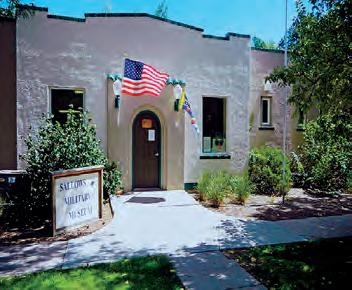


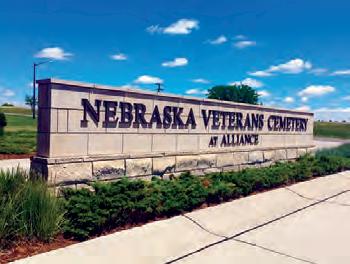



Planyourgetawaynowbyvisiting www.visitalliance.com

Canyon de Chelly, in the Four Corners region of northeastern Arizona, is among the most spectacular natural wonders of the American Southwest. It is also one of the longest continuously inhabited places in North America. Archaeologists estimate humans have lived in the canyon for more than four millennia. By the late 17th century Navajos had made their home there, and in the 19th century they waged two battles in Canyon de Chelly central to tribal history.
The canyon floor is anywhere from 100 to 300 yards wide and flanked by sheer red rock walls up to 1,000 feet high. About 3 miles from its east entrance the canyon splits into two main branches, with Canyon del Muerto running off to the northeast. Five miles up Canyon del Muerto is another junction at a prominence called Fortress Rock. Black Rock Canyon splits off due east, while Canyon del Muerto courses another 15 miles northeast.
In January 1805 a force of 500 Spanish soldiers under the command of Lieutenant Antonio Narbona entered Canyon de Chelly in response to a Navajo raid against the Spanish military post at Cebolletta. In the resulting battle near the northeast end of Canyon del Muerto the Spanish claimed to have killed 115 Navajos, including 90 warriors, while taking 33 women and children as slaves. Navajo tradition relates a different story—that most of the warriors were away hunting that day, and almost all of those killed were women and children. As the Spanish troops approached, the Navajos sheltered in a cliff dwelling high on the canyon wall, where they were trapped and picked off by Narbona’s marksmen. The only Spanish casualty was a soldier tackled by a Navajo woman while he was scaling the cliff. Both fell to their deaths. Narbona ended his career as the fifth Mexican governor of New Mexico.

Fifty-nine years later the Navajo fought another battle in Canyon de Chelly, this time against the United States. While the Civil War was raging east of the Mississippi, the U.S. government sent troops to the Southwest to put an end to persistent raids by emboldened Navajos. In 1864 Brig. Gen. James H. Carleton, commander of the military Department of New Mexico (which spanned what today comprises New Mexico
and Arizona), ordered Lt. Col. Kit Carson of the 1st New Mexico Volunteer Cavalry to clear the canyon of Navajos and relocate them to a reservation at Bosque Redondo, nearly 400 miles southeast at Fort Sumner, New Mexico Territory. That January 12, in the face of a blinding snowstorm, Carson led 389 troopers into Canyon de Chelly. The Navajos, under the leadership of Chiefs Barboncito and Manuelito, skillfully used skirmishing parties to fight delaying actions while their main body withdrew into Canyon del Muerto. On reaching the junction with Black Rock Canyon, they scaled Fortress Rock with the help of ladders prepared ahead of time. By the time Carson’s force reached the far end of Canyon del Muerto, it had destroyed the tribe’s camps, crops and supplies and taken more than 200 captives. But more than 1,000 Navajos had evaded to the top of Fortress Rock, where they had stockpiled food. It wouldn’t be enough.
Biding his time, Carson withdrew from the canyon to wait out the Navajos, who were bereft of the necessities to survive winter. The strategy worked. By that summer Carson had accepted the surrender of some 8,000 Navajos, the largest such capitulation in American Indian history. In its wake the Navajos were forced to make what they recall as the “Long Walk” to Bosque Redondo. But the tactical success for the U.S. government turned out to be a strategic failure in the end. Some 3,000 Navajos died at the meagerly supplied reservation before they were finally allowed in 1868 to return to their homeland in the Four Corners region.
Present-day Canyon de Chelly (pronounced “de SHAY”) National Monument lies entirely within the boundaries of the Navajo Nation, thus all visitors to the canyon floor must be accompanied by a licensed Navajo guide. Its sheer walls are pocked with the ruins of centuries-old cliff dwellings and etched with pictographs. A particularly striking 200-year-old pictograph on the wall below Massacre Cave depicts the invading Spanish cavalry force, replete with lances and crossbearing tunics. The North Rim Drive provides a number of spectacular overlooks, including Antelope House Overlook (directly across from Fortress Rock) and Massacre Cave Overlook, while the South Rim Drive ends at an overlook of the 750-foot sandstone spire known as Spider Rock. There is just no substitute, however, for exploring the canyon floor with a knowledgeable guide, one for whom it is especially personal hallowed ground. MH


Can you match the following figures with their notable achievements in the field of military medicine?
1. Richard Rowland Kirkland
2. Mary Edwards Walker
3. Richard Alexander Henderson
4. Marie Marvinqt
5. James Henry Reynolds
6. Dominique Jean Larrey
7. Desmond Doss
8. W illiam R. Charette
9. Mariana Dragescu
10. John Simpson Kirkpatrick
A. Napoléonic surgeon, developed the “flying ambulance”

B. Australian stretcher bearer at Gallipoli, 1915
C. Romanian medical evacuation pilot, 1941–45


D. Navy corpsman, Medal of Honor, Korea, 1953

E. Field surgeon, Medal of Honor, 1861–64

F. Conceived air evacuation, 1910
G. Surgeon at Rorke’s Drift, 1879
H. First conscientious objector awarded Medal of Honor, 1945



I. Confederate “Angel of Marye’s Heights,” 1862
J. New Zealander stretcher bearer at Gallipoli, 1915
Answers:
Can you identify the following famous/infamous snipers?
A. Simo Häyhä
B. Carlos Hathcock
C. Vasily Zaitsev
D. Noah Adamia
E. Maksim Passar

F. Chris Kyle


H. Herman Davis
I. Craig Harrison
J. Hiram Berdan
Answers:
1. What did No. 9 Squadron, Royal Air Force, introduce over Le Hamel, France, on July 4, 1918?
A. Supplies dropped by parachute

B. Ferrying troops to the front
C. Air transporting commanders
D. Aircraft aiding in POW escape
2. Which was the first island to be conquered entirely from the air?
A. Guernsey
C. Crete
3. Which airplane was regularly used to fly secret agents in and out of Axis-occupied territory throughout World War II?
A. Douglas C-47 Skytrain
B. Stinson L-5 Sentinel
C. Polikarpov Po-2
D. Westland Lysander
4. What assault was heralded by an airdrop of U.S. and Australian regiments on Sept. 5, 1943?
A. Salerno

C. Naples
5. The crash of which airplane at Tan Son Nhut Airbase on April 4, 1975, killed 138 passengers— including 78 children—during Operation Babylift?
A. C-5A
C. C-141
Improvements in aircraft led to mass supply and evacuation ops. Do you recall any of the following? Visit
Answers: 1A, 2C, 3D, 4B, 5A
What began as a modest proposal to bring Lincoln enthusiasts together for a small East Coast-based yearly history conference at Gettysburg has blossomed into one of the leading history organizations in the country.
Our yearly November symposium is attended by scholars and enthusiasts from all over the nation and abroad. It attracts speakers and panelists who are some of the most revered historians in the Lincoln and Civil War fields.
On Sept. 27, 1940, amid the “Blitz”—Germany’s eight-month bombing campaign against Britain—incendiary bombs fell on historic Holland House in Kensington, London. Firemen were only able to save its east wing and the library, which apparently remained open for browsing. The 1605 country manor had hosted such literary greats as Lord Byron and Charles Dickens, who likely rolled in their graves at the loss of so many rare volumes.



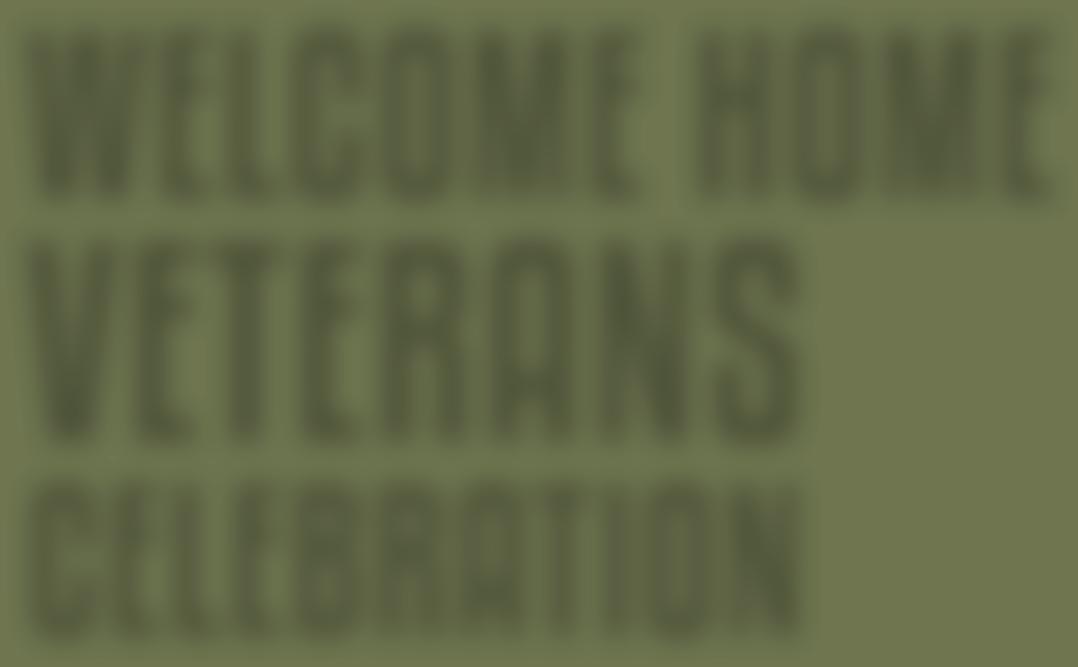


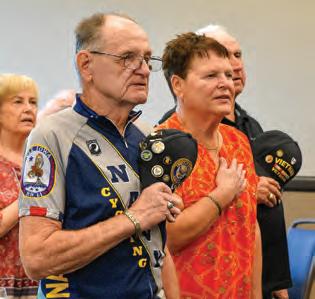

Each one of our 1/30 scale metal figures is painstakingly researched for historical accuracy and detail. The originals are hand sculpted by our talented artists before being cast in metal and hand painted – making each figure a gem of hand-crafted history.
Please visit wbritain.com toseeall these figures andmore from many other historical eras.









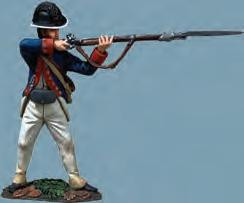






The birth of the modern United States Army can be traced to the early 1790s when it was transformed from a mere constabulary regiment to the Legion of the United States.
Under General Anthony Wayne the regular army (often referred to as Wayne’s Legion) marched



into northwestern Ohio where they engaged Native warriors in a battle known as Fallen Timbers.




This action led to the Treaty of Greenville, followed by the Jay’s Treaty, the withdrawal of British military presence in the area and thus opening the land for westward expansion.

